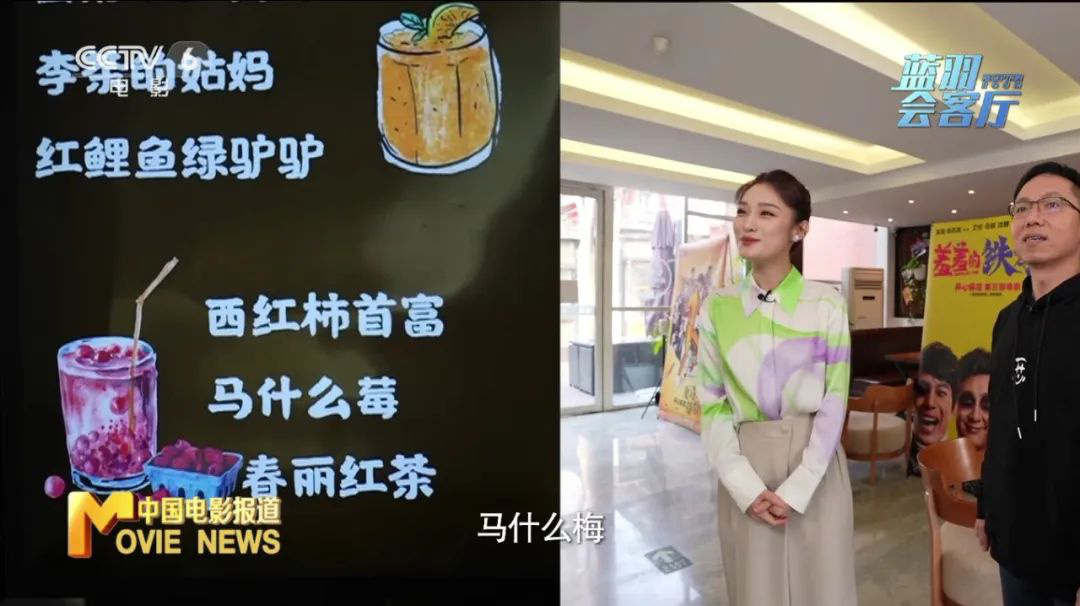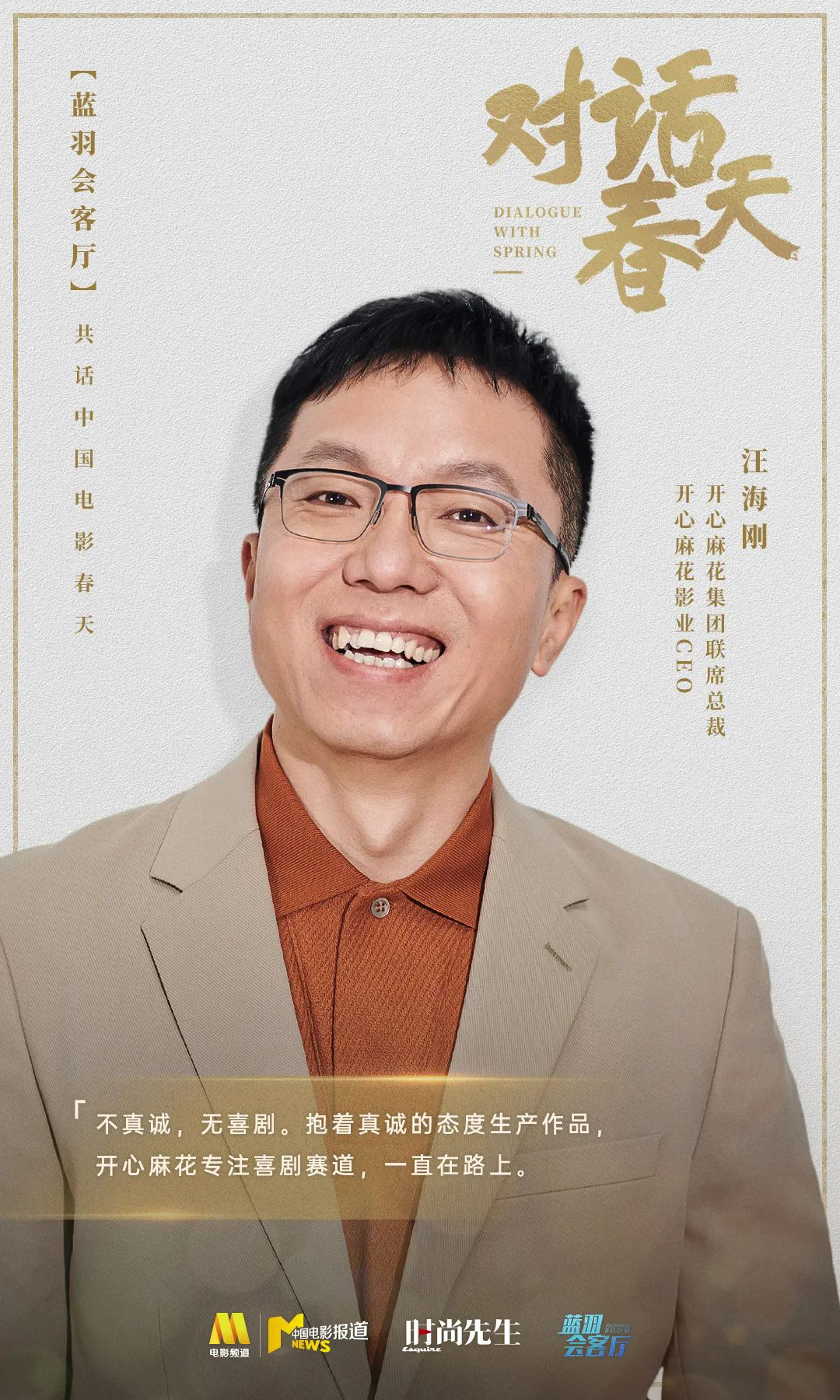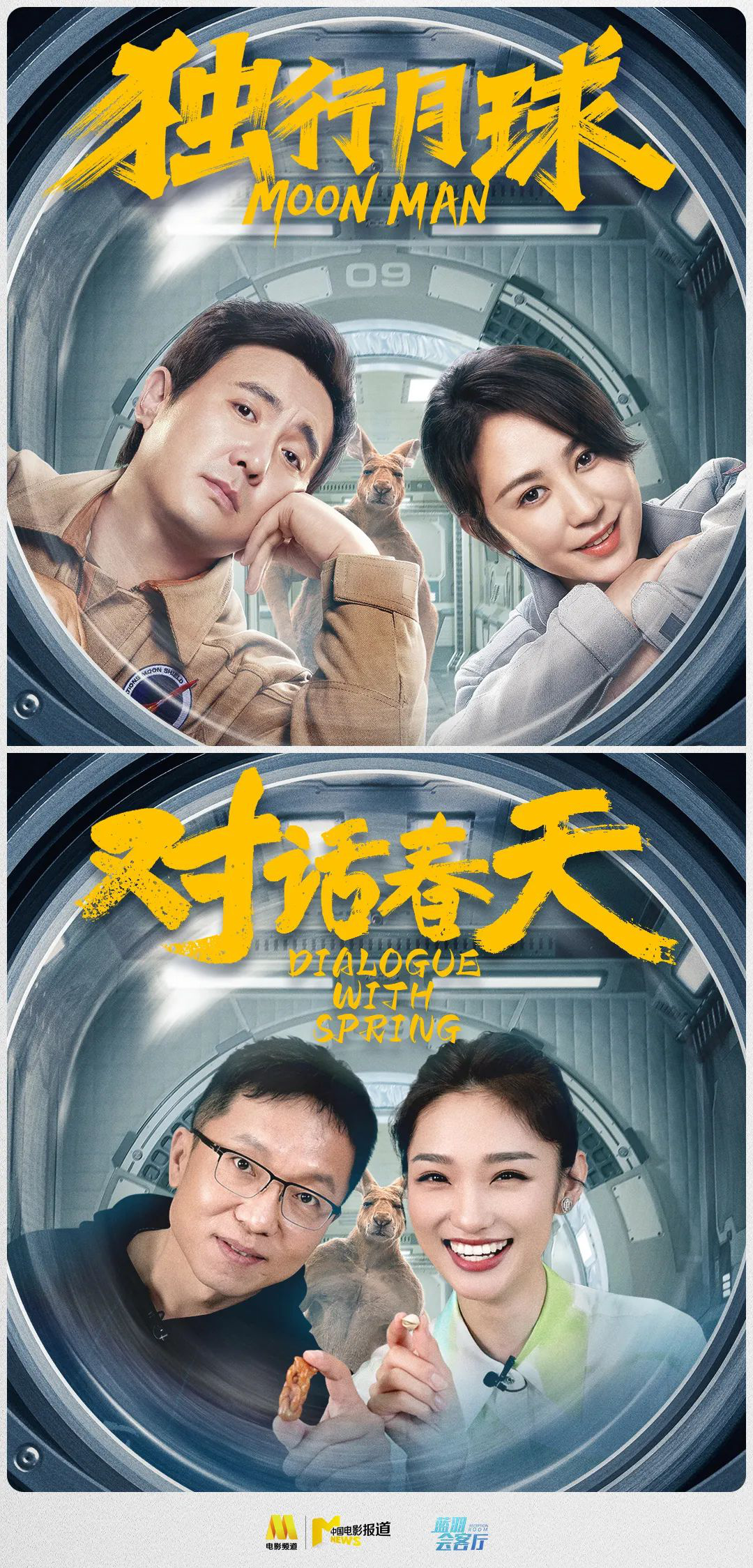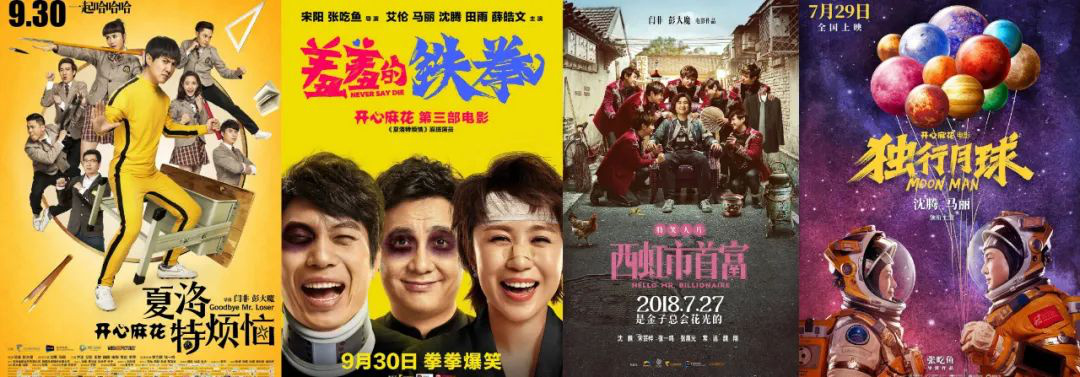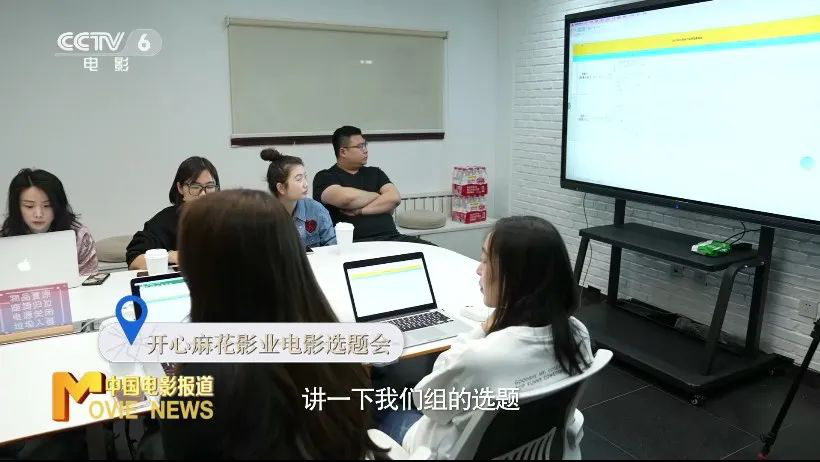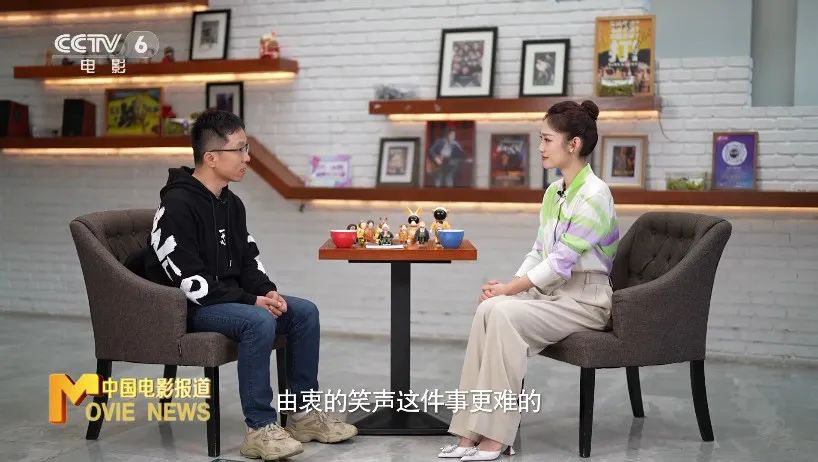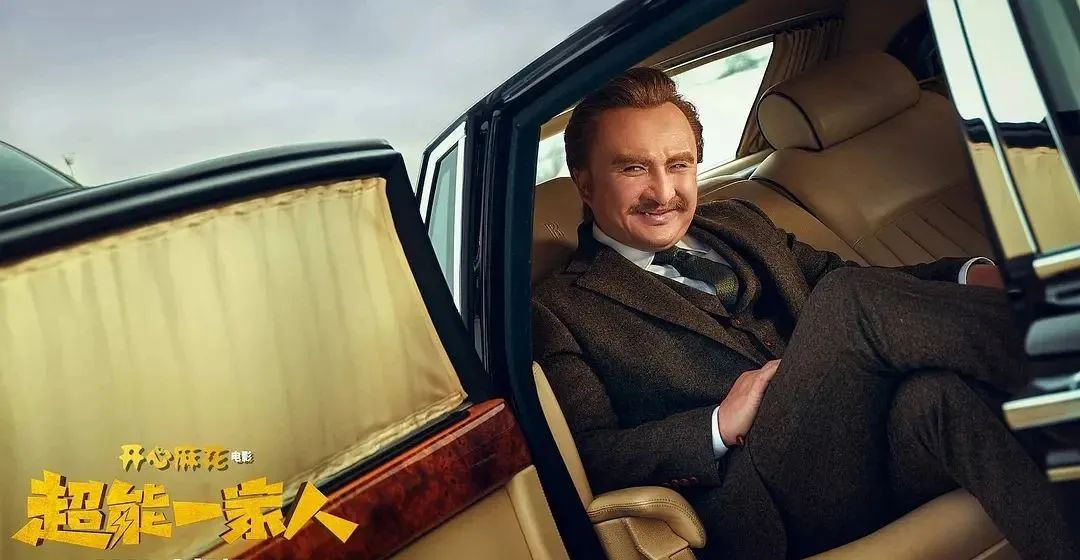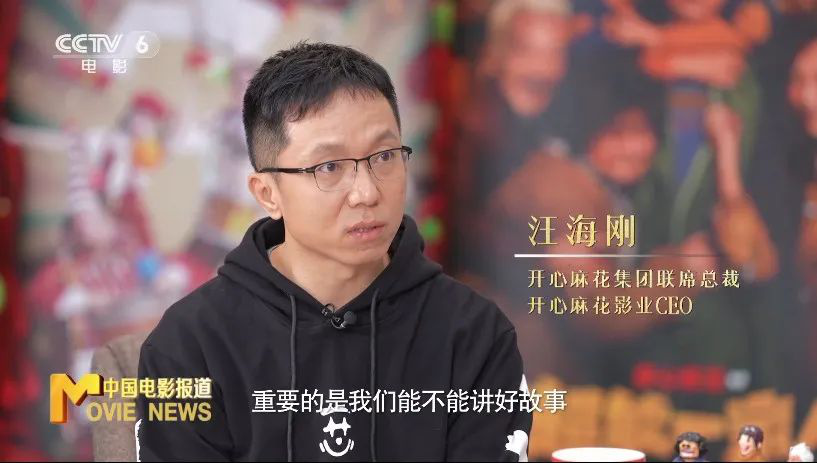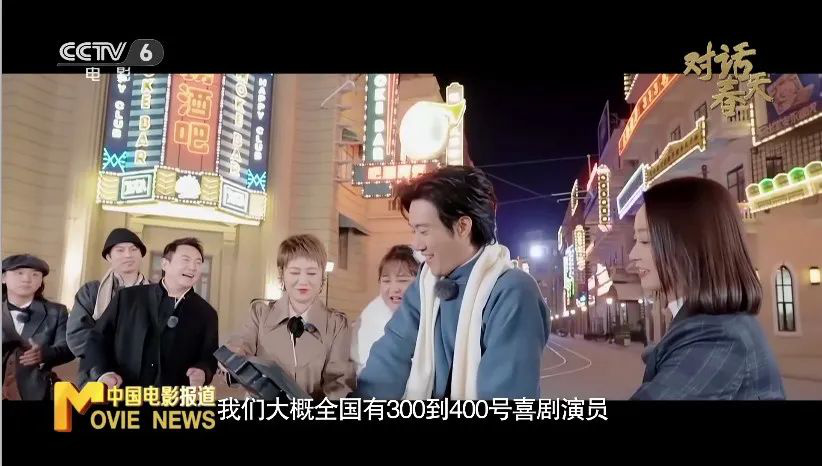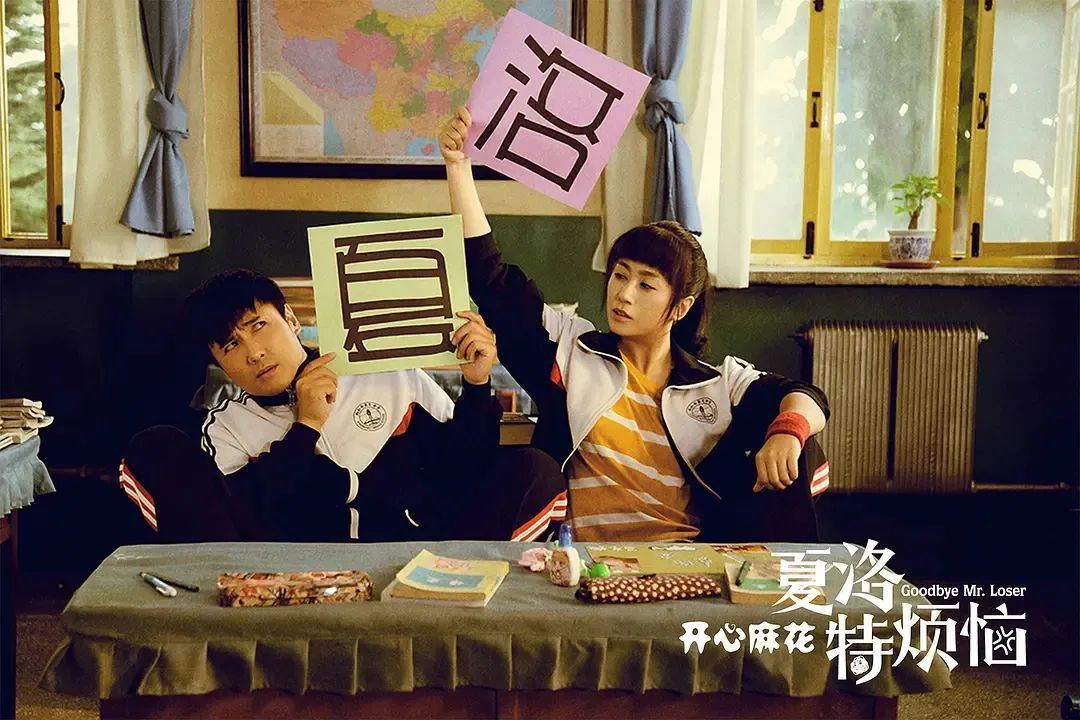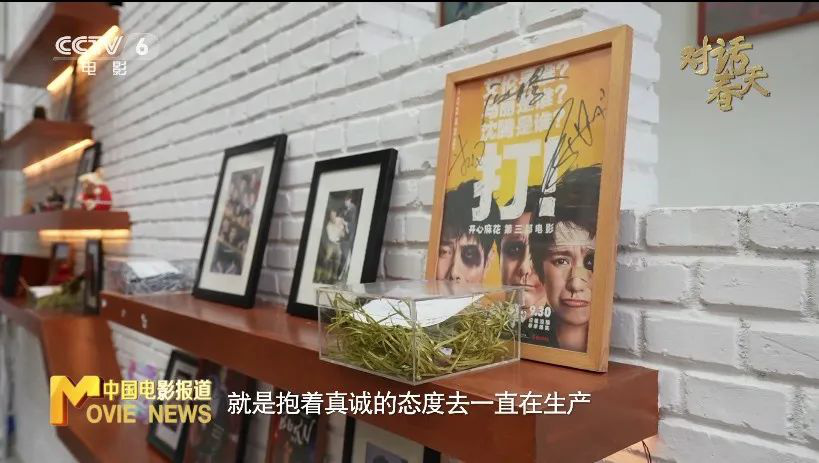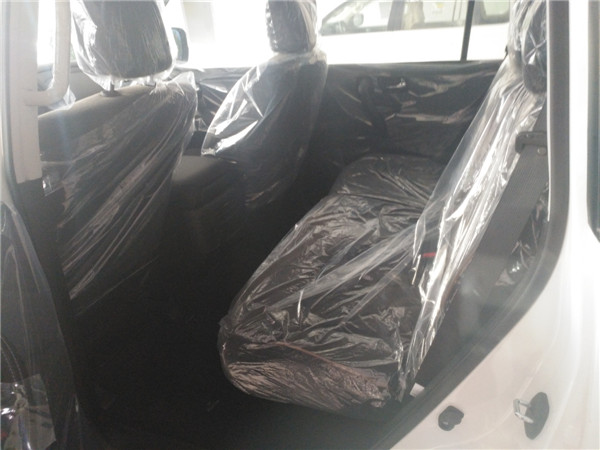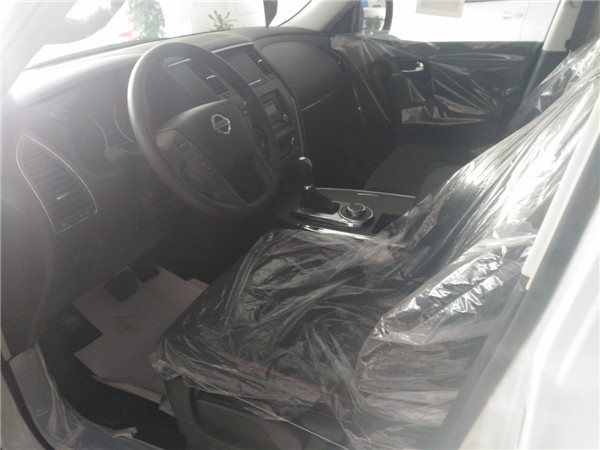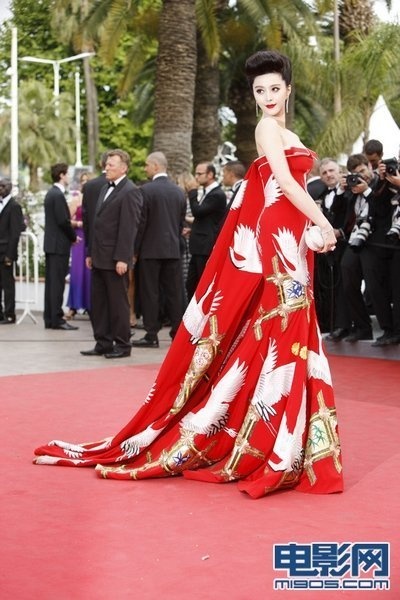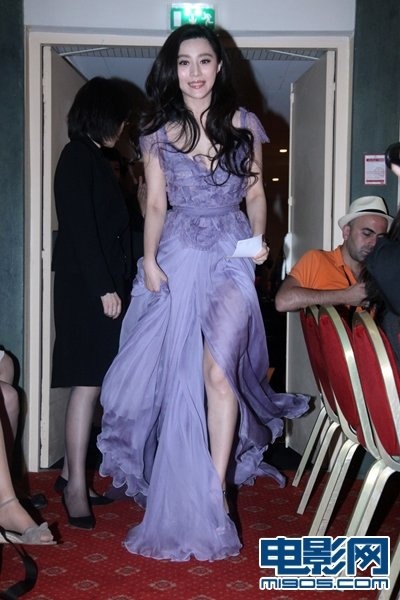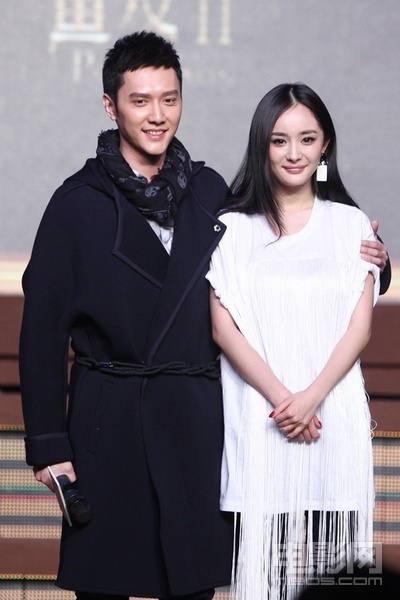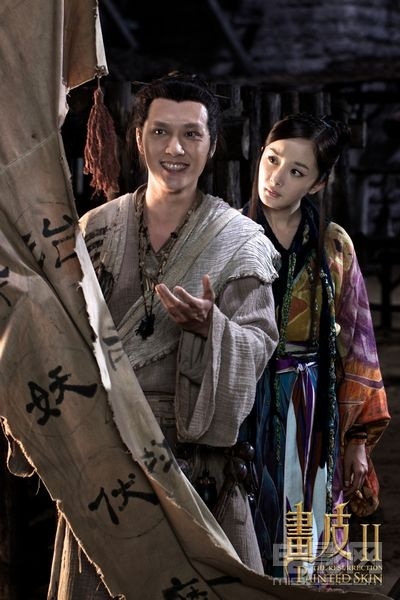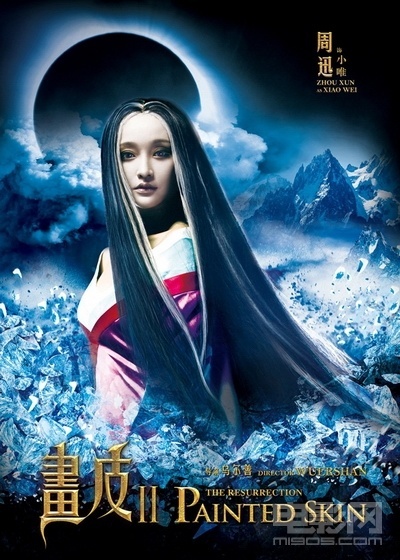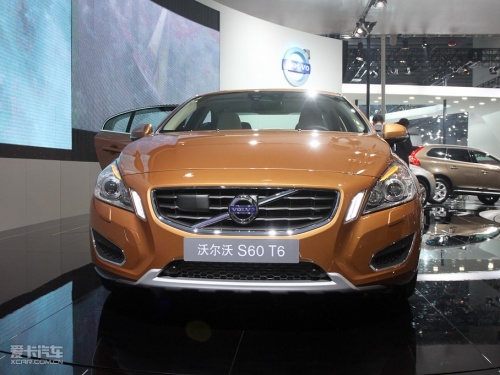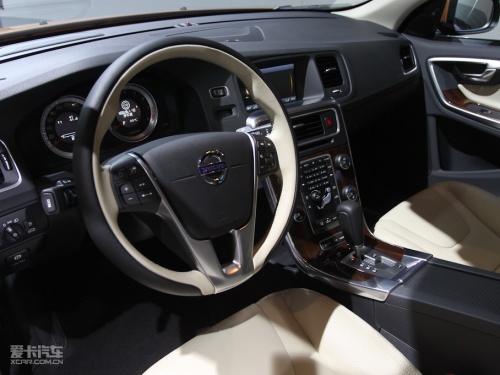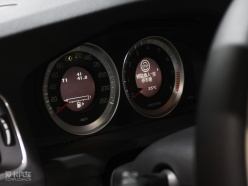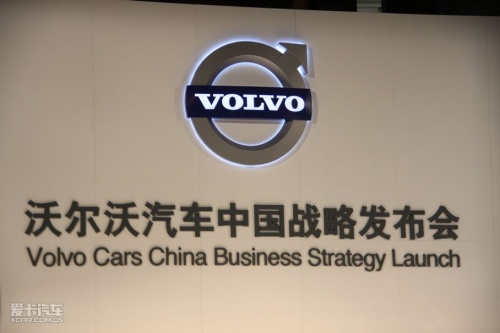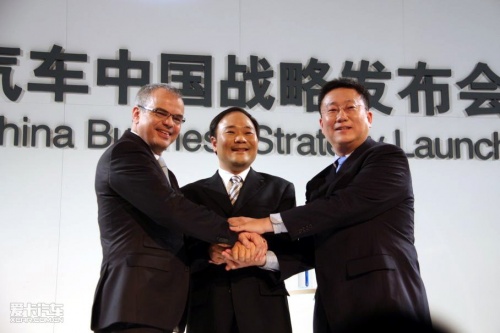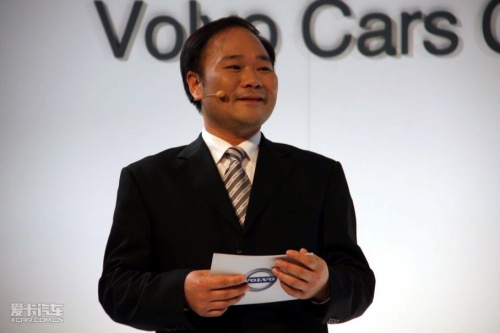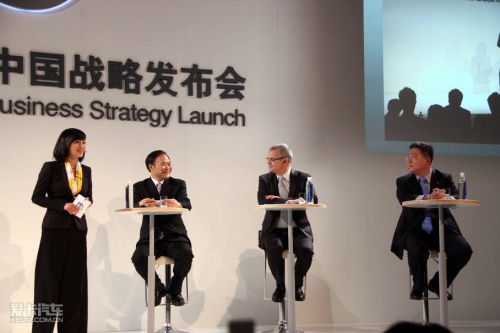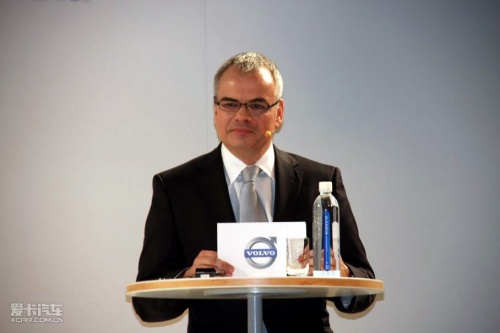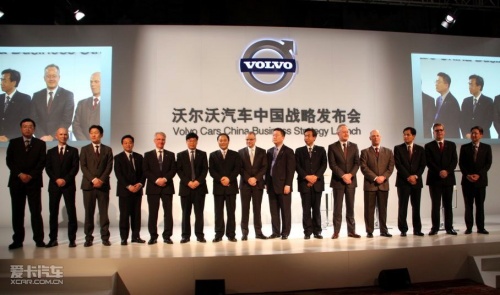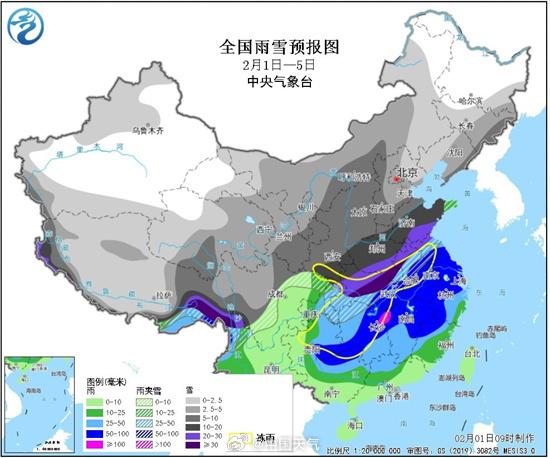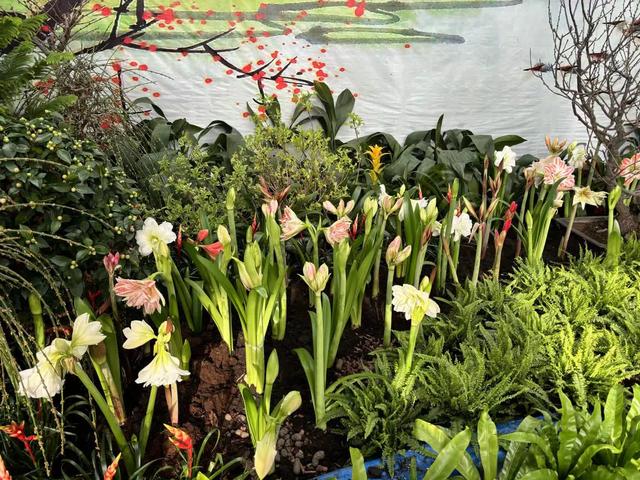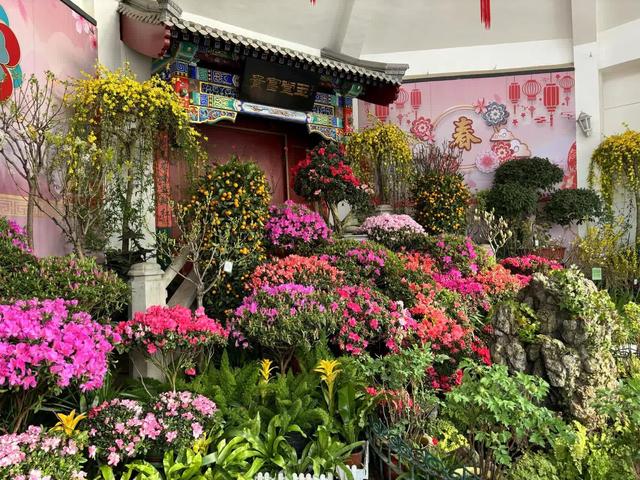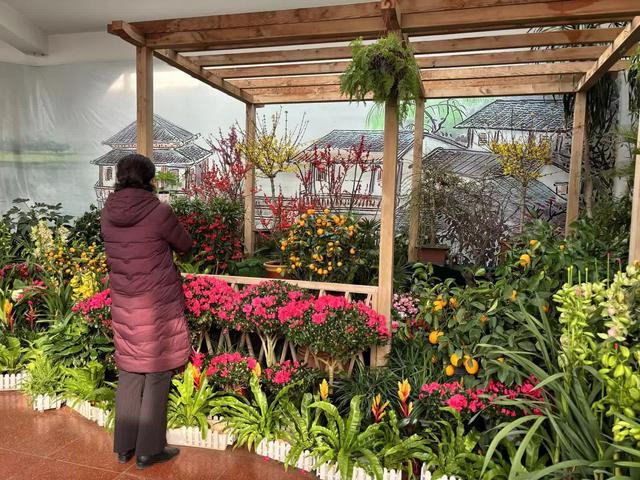State and municipal people’s governments, provincial committees, offices, departments and bureaus:
The "14 th Five-Year Plan" for digital Yunnan is hereby printed and distributed to you, please implement it carefully.
Yunnan Provincial People’s Government
April 27, 2022
(This piece is publicly released)
![ZF26+[ Internal ]-2.jpg](http://www.stgc.com.cn/wp-content/uploads/2023/12/V8wWltU8.jpg)
![ZF26+[ Internal ]-3.jpg](http://www.stgc.com.cn/wp-content/uploads/2023/12/f6wDou51.jpg)
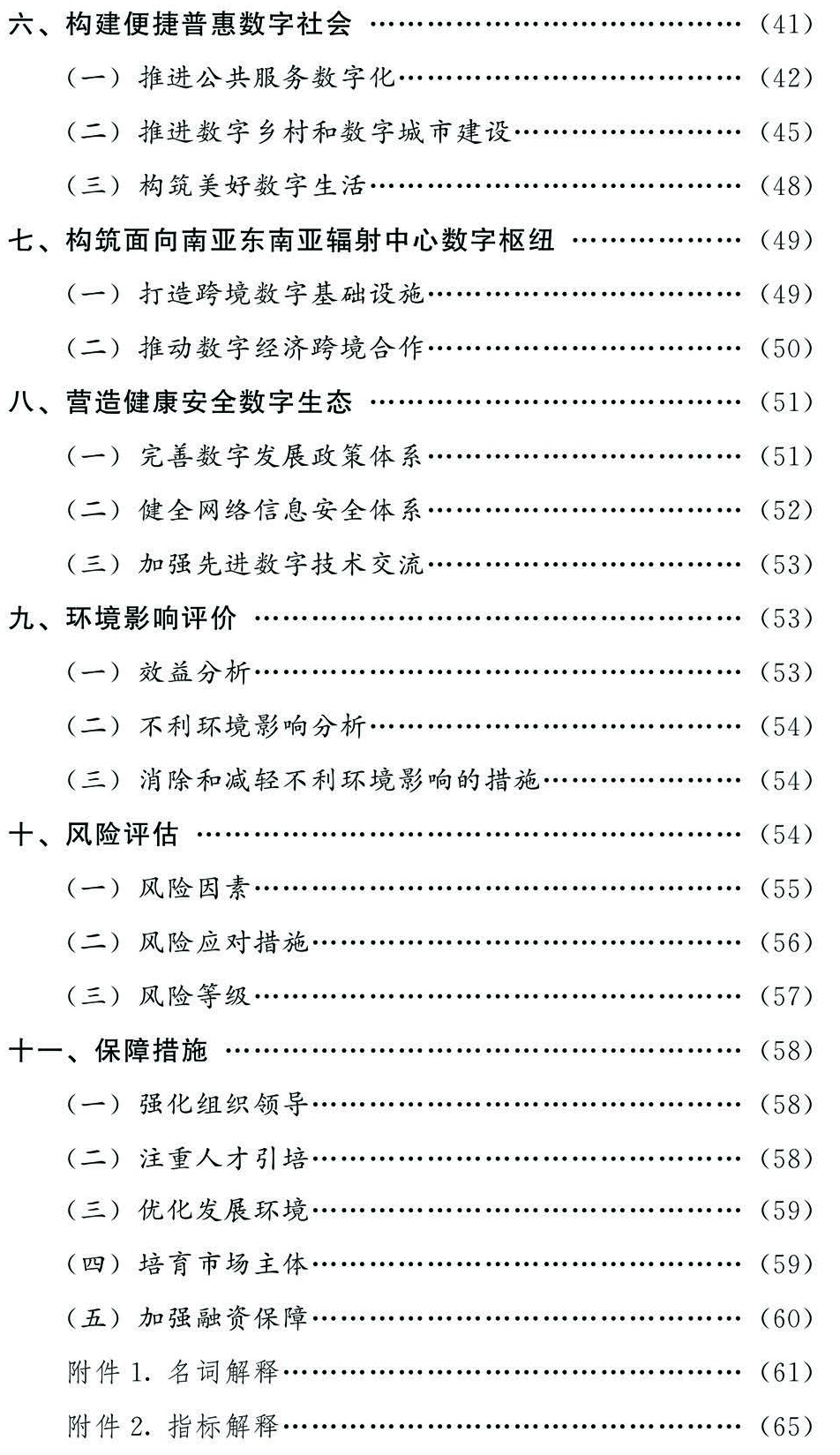
This plan is formulated in accordance with the 14th Five-year Plan for National Economic and Social Development of Yunnan Province and the Outline of Long-term Objectives for the Year 2035, in order to thoroughly implement the decision-making arrangements of the CPC Central Committee and the State Council on speeding up digital development, promoting the construction of digital China, seizing the great opportunity of a new round of scientific and technological revolution and industrial transformation, vigorously promoting the construction of "digital Yunnan", and using "digital" to empower the economy, improve the quality of development, and improve governance and efficiency.
I. Development Foundation and Situation
(A) development achievements
During the "Thirteenth Five-Year Plan" period, the provincial party committee and government planned to build "Digital Yunnan" with a high sense of historical mission. The digital foundation has been continuously consolidated, the digital industry has developed rapidly, and the digital application has accelerated innovation, creating a number of "single champions" who are well-known throughout the country. Digital development has become an important engine to promote the high-quality leap-forward development of Yunnan.
Positive progress has been made in the construction of digital infrastructure. The construction of information infrastructure has been continuously accelerated, and the construction of all-optical network province has been completed. Fixed broadband has achieved 100% coverage of administrative villages, and the inter-provincial Internet bandwidth capacity has reached 28Tbps (terabits per second). Remarkable achievements have been made in the construction of mobile communication facilities, with 215,000 4G base stations built, 100% coverage of 4G network administrative villages and 19,000 5G base stations completed. The data center has begun to take shape, and the number of standard racks of data centers in the province has exceeded 40,000. Yunnan Key Laboratory of Artificial Intelligence, Yunnan Massive Language Information Processing Engineering Laboratory and other research institutions have been completed successively, and many research achievements in language processing in South Asia and Southeast Asia have reached the domestic leading and international advanced level.
The governance capacity of digital government has been continuously improved. The ability of government service has been continuously strengthened, and the national platform has been basically built, and the online government service platforms at the provincial, prefecture, county, township and village levels have been connected. The online service rate of government service matters is 95%, the whole process of online service and the zero running rate are 34%, and the "one online service" has been initially realized. Create a "one mobile phone service" APP, realize 1363 items of 20 service themes, and build a "ubiquitous" mobile government service. The ability of social management has been continuously improved, public security governance has become more accurate, high-definition video surveillance of public security has been continuously improved, and a new generation of mobile police terminals have achieved 100% access to the network. The level of digital traffic management has improved rapidly, and the optical network and sensing network of expressways in the province have taken shape, realizing real-time collection of road network operation information in some sections. Positive progress has been made in the construction of digital ecological civilization. The Yunnan Environmental Resources Data Center has been continuously upgraded, gathering more than 560 million ecological environment data, initially building a "map" of forestry resources, and building specialized question banks such as flood control, drought relief and water resources, effectively supporting the development of digital ecological applications.
The development of digital economy has entered the fast lane. The scale of digital industrialization has achieved rapid growth. In 2020, the province’s information industry achieved a main business income of 170.3 billion yuan, and the average annual growth rate during the "Thirteenth Five-Year Plan" period exceeded 20%. In the electronic information manufacturing industry, mobile terminals and displays were made in Yunnan, and silicon wafers were mass-produced, successfully breaking through a number of rare and precious metal electronic materials technologies. In terms of software and information technology services, the first provincial-level blockchain center in China was established with blockchain as a breakthrough, and a number of application demonstrations were created in the fields of commodity traceability, public resource transactions and electronic bills. The digital transformation of the industry has been accelerated, and the application scenarios of the industry have been continuously expanded. In terms of agricultural digitalization, 105 e-commerce comprehensive demonstration counties have been built, ranking first in the country. In terms of digitalization of manufacturing industry, a total of 73 provincial-level intelligent manufacturing pilot demonstration projects have been implemented, which effectively promoted the improvement of production efficiency and the reduction of operating costs. In terms of digitalization of the service industry, the construction of "a mobile phone travels to Yunnan" will continue to be carried out to realize digitalization and intelligence of tourist services and industry supervision. The construction of smart logistics has achieved remarkable results, and the Yunnan regional exchange node of the national transportation logistics public information platform and the Yunnan international "modern logistics cloud" comprehensive information service platform have been built.
The construction of digital society has been accelerated. The storage of residents’ electronic health records and population information data continued to advance, and 650,000 residents’ electronic health cards (codes) were distributed in the province, realizing "one-code communication" for medical treatment. Public service platforms for educational resources have been deployed in all provinces, cities, counties and districts of the province, providing more than 1.2 million teaching resources. Establish a social insurance system and a public employment service system. It took the lead in the whole country to realize the electronic distribution of social assistance funds and issue social security cards loaded with financial functions. The number of social security card holders in the province exceeded 45 million, and the coverage of social security continued to expand. The provincial smart pension platform has entered nearly 4,000 major pension institutions in the province, realizing the unified management of pension service institutions.
The construction of digital cities has achieved initial results. Wuhua District of Kunming, Yuxi City, Dali City, mengzi city City, Maitreya City and wenshan city City have successively become national smart city pilots, initially realizing the digitalization of urban management and effectively promoting the innovation and development of digital cities in the province. A number of municipal governance center platforms will be built, equipped with grid information collection equipment, and a grid management system covering states, cities, counties, districts, townships and villages will be formed to effectively improve the modernization level of social governance. The "just brush your face" project has been accelerated, and a number of hotels, tourist attractions and business districts have realized brushing their faces to stay, brushing their faces into the park and paying for them.
The construction of digital hub for South Asia and Southeast Asia Radiation Center has been steadily advanced. Kunming has become the fourth city in China with three international communication import and export bureaus of basic telecommunications enterprises. Our province has built cross-border transmission optical cables and international channel entrances and exits with Myanmar and Laos, with an international transmission bandwidth of 1.03Tbps, and the service capacity of international network information infrastructure has been significantly improved. Significant achievements have been made in the development of cross-border trade. In 2020, the import and export scale of cross-border electronic commerce in Yunnan Province will reach 1.353 billion yuan. A public service platform will be built in cross-border electronic commerce, Yunnan Province to provide "one-stop" services such as customs clearance, inspection, financing and logistics, and a business portal platform for China-ASEAN Free Trade Area will be established to actively promote cross-border e-commerce cooperation. Build a "single window" for China (Yunnan) international trade, and realize full coverage of paperless customs clearance at several border areas in the province. The digital platform of the South Expo was launched and the "Never Ending South Expo" was successfully held.
(2) Existing problems
Although the province’s digital development has achieved phased results, there are still some problems, such as weak digital foundation support, weak digital economy competitiveness, insufficient digital innovation and application, low level of data sharing and coordination, and insufficient digital element guarantee.
First, the supporting capacity of digital foundation is weak. Our province does not belong to the national Internet backbone direct connection point, and has not yet built a dedicated channel for Internet data. The Kunming International Communication Import and Export Bureau does not yet have Internet landing services, and its traffic convergence ability is not strong in the national network structure layout, and its hub status needs to be improved urgently. The digital divide between urban and rural areas still exists, and about 5,000 natural villages with more than 20 households in the province have not achieved 4G network coverage. The digital foundation of the government is relatively weak, the application support ability is insufficient, and a unified public core basic platform has not been established. The "vertical strength and horizontal weakness" and "scattered fragments" in the construction of government information are widespread. 39.6% of government information systems run on business private networks, and all kinds of vertical business private networks are self-contained. Most of them are closed to each other and cannot be effectively connected with the government extranet, which restricts the digital transformation of the government.
Second, the digital economy is not competitive. In 2020, the added value of the core industries of the digital economy in the province will only account for 3.85% of GDP, far below the national average of 7.80%. The industry lacks leading enterprises and unicorn enterprises, and its application and innovation ability in core technology fields such as big data, artificial intelligence and blockchain is insufficient, and its overall competitiveness is weak. The level of digital transformation of key industries is still not high, and the technical applications such as industrial Internet, energy Internet and agricultural Internet of Things have not been promoted on a large scale. The development of "going to the cloud to use numbers to give wisdom" has just started. The digital transformation platform and public service supply of small and medium-sized enterprises are still insufficient, and the extensive and inefficient development mode of traditional industries has not been fundamentally changed.
Third, the application of digital innovation is not enough. The breadth and depth of digital applications in public services, social governance and other fields are still insufficient, and the level of service facilitation and generalization still needs to be improved. The input and operation burden of grass-roots system is heavy, and the innovation level of digital application in government governance, urban management and other fields is low. The demand for data center applications is insufficient, and the utilization rate of big data centers in the province is only about 25%, and the effectiveness of digital empowerment has not been fully released. There is still a lack of understanding of digital development in various fields and departments, and digital literacy needs to be improved. In the process of digital construction, the thinking is unclear, the focus is not prominent, and the development support is weak. Digitalization has not achieved a comprehensive breakthrough in all industries and fields.
Fourth, the level of data sharing and collaboration is not high. The intensive level of government information system construction in the whole province is not high, the phenomenon of "stack effect" is obvious, and there are a large number of "information islands". The data exchange and sharing mechanism between government departments has not yet formed, and the data barriers are still outstanding. The existing 457 major government information systems of provincial party and government organs are built by 185 software vendors, and adopt different technical architecture standards and norms. The effective development and utilization of data resources is insufficient, the synergistic effect of mobile government applications has not been brought into play, and the application fields are limited, which has not formed a global situation of letting a hundred flowers blossom. The integration of government data with market and social data is insufficient, and the ability of economic and social governance needs to be improved.
Fifth, the protection of digital elements is insufficient. The institutional guarantee at the provincial, city and county levels needs to be further optimized, and the guarantee of development policies, funds and other factors needs to be further enhanced. There is a big gap in professionals related to digital economy, especially high-end talents, entrepreneurs and practical talents with complex business and technology. The cooperation among enterprises, universities and scientific research institutes in the province is not close enough, which fails to form the development trend of Industry-University-Research’s integration. Insufficient investment in innovation. In 2020, the investment intensity of R&D in the whole province is only about 1%, far below the national average of 2.4%, which cannot meet the innovation requirements of digital development.
(3) Facing the situation
From the international situation, the world has entered the era of the fourth industrial revolution characterized by digitalization, networking and intelligence. The innovation cycle of digital technology represented by 5G, cloud computing, big data, artificial intelligence and blockchain has been greatly shortened, and the innovation vitality, agglomeration effect and application potential have been accelerated. Digital technology is fully integrated and infiltrated into all fields of economic and social life, and its empowerment on social governance, production and life has been rapidly enhanced. Digital development has become the goal of all countries to reshape global competitiveness and seek.
From the domestic situation, since the 18th National Congress of the Communist Party of China, focusing on the strategic overall situation of the great rejuvenation of the Chinese nation and the unprecedented changes in the world, from the strategic height of realizing the goal of "two hundred years", General Secretary of the Supreme Leader has repeatedly stressed that it is necessary to adapt to the new historical position of China’s development, fully implement the new development concept, speed up the construction of a network power and a digital China, vigorously develop the digital economy, cultivate new kinetic energy with informationization, promote new development with new kinetic energy, and create new glory with new development. The CPC Central Committee and the State Council put the acceleration of digital development to an unprecedented height, and set up a special chapter for digital development in the 14th Five-Year Plan for National Economic and Social Development of People’s Republic of China (PRC) and the Outline of Long-term Goals in 2035.
Judging from the situation in the province, at present, our province is in a critical period of changing the development mode, optimizing the economic structure, and transforming the growth momentum. The Supreme Leader General Secretary visited Yunnan twice and delivered important speeches. Standing at the height of history and overall situation, he made incisive judgments and gave precise guidance on the characteristics, development orientation and work priorities of Yunnan province, which further opened the horizon and pointed out the path for the development of Yunnan in the new era. During the "Thirteenth Five-Year Plan" period, the provincial party committee and government attached great importance to the development of digitalization, took digitalization as a major measure to promote high-quality development, and insisted on the simultaneous promotion of digital economy, digital government, digital society and digital city. The integration and innovation of digital technology with various fields of the province’s economy and society continued to deepen, forming a number of application demonstrations with national influence, providing strong support for promoting steady growth, restructuring and benefiting people’s livelihood.
Second, the overall requirements
(A) the guiding ideology
Guided by the Supreme Leader’s Socialism with Chinese characteristics Thought in the New Era, we will fully implement the spirit of the 19th National Congress of the Communist Party of China and the previous plenary sessions of the 19th National Congress, thoroughly implement the important exposition of the Supreme Leader’s General Secretary on the network power and digital China, and inspect the spirit of Yunnan’s important speech. Based on the new development stage, we will fully, accurately and comprehensively implement the new development concept, integrate into the new development pattern, take promoting high-quality development as the theme, take innovation as the guide and data as the core, consolidate digital infrastructure and deepen digital open cooperation; Adhere to the principle of problem-oriented, demand-driven, focus on the needs of the people, proceed from the reality of economic and social development, jointly promote the construction of digital economy, digital government and digital society, and drive the transformation of production mode, lifestyle and governance mode with digital transformation to provide strong support for Yunnan’s high-quality leap-forward development.
(2) Main principles
Driven by innovation, leading development. In-depth implementation of the innovation-driven development strategy, enhance the innovation and application ability of a new generation of digital technology, promote industrial innovation with scientific and technological innovation, promote digital development in various fields of economy and society with institutional and institutional innovation, and build a digital application province.
Intensive sharing, joint construction and sharing. Strengthen the overall construction of "Digital Yunnan", promote the integration of infrastructure and application systems, accelerate the realization of network interconnection, information exchange and resource sharing, avoid "information technology barriers" and "software systems are fragmented" to the maximum extent, and strive to maximize the social benefits of digital resources.
Overall layout, coordination and progress. We will implement the regional coordinated development strategy of "the rise of central Yunnan, the opening up along the border, the development of northeast Yunnan and the integration of west Yunnan", give full play to our comparative advantages, promote the integrated development of urban and rural areas and cross-regional cooperation, and form a new pattern of regional digital coordinated development with strong overall planning, orderly competition, complementary advantages and win-win sharing.
Open cooperation, mutual benefit and win-win situation. Take the initiative to serve and integrate into the national development strategy, and seize the opportunities of Guangdong-Hong Kong-Macao Greater Bay Area and Chengdu-Chongqing economic circle to accelerate industrial cooperation. Actively participate in the construction of the "Belt and Road", build an export-oriented digital economy development model, and build a digital hub for South Asia and Southeast Asia Radiation Center.
Active and steady, safe and orderly. Accelerate the construction of a ubiquitous, intelligent, safe and reliable digital basic support system, strengthen network and information security supervision, implement safety management responsibilities, adhere to the synchronous planning, construction and operation of safety guarantee and projects, and ensure the safety of networks, applications and data.
(3) Development goals
By 2025, the digital infrastructure will be improved, the digital economy will become an important growth point of economic development, the service mode of digital society will be rapidly innovated, and the efficiency of digital government operation and governance will be significantly improved, providing people with a safe, comfortable and convenient modern and intelligent living environment.
Digital infrastructure is ubiquitous in Zhilian. The information infrastructure has been upgraded in an all-round way, and the fiber-optic broadband network, wireless broadband network and Internet of Things have achieved deep coverage. The networking and intelligent upgrading of infrastructure in key cities have been basically completed, and the province’s integrated big data center system has been built. Infrastructure such as artificial intelligence and blockchain strongly supports social governance, public services and production and life applications.
The development momentum of the digital economy is strong. The competitiveness of digital technology has improved significantly, forming a number of industrial clusters with certain innovation ability and obvious comparative advantages. The scale of digital industrialization has grown significantly, digital technology and the real economy have been deeply integrated, the digital transformation of traditional industries has been further promoted, and new kinetic energy for the development of digital economy has been rapidly released.
Digital government realizes efficient collaboration. We will further promote the combination of scientific and technological innovation and the government’s own revolution, and realize the cross-level, cross-regional and cross-industry network connection between party and government departments, the integration and sharing of data resources, the efficient coordination of business processes, the scientific wisdom of government decision-making, and the accurate and effective social governance. The level of "Internet+government services" has been greatly improved, and government services have basically been handled online.
It is convenient for the digital society to achieve universal benefits. An efficient and convenient digital public service system has been formed, and remarkable achievements have been made in the digital construction of people’s livelihood areas such as education, medical care, old-age care, transportation, etc., urban digital infrastructure has become more complete, digital urban governance has leapt, the level of digital rural governance services has been significantly improved, the digital development of people’s lives has accelerated, and citizens’ digital literacy has been continuously improved.
The digital hub for South Asia and Southeast Asia Radiation Center was initially built. Strive to upgrade the Kunming regional international communication service import and export bureau to a full-service bureau and build a national-level Internet backbone direct connection point in Kunming. The international export bandwidth of the Internet has been further expanded. The "going out" of the digital economy has achieved remarkable results. The cooperation with neighboring countries in the fields of digital technology, digital trade, digital finance and digital humanities exchange has been further deepened, and cross-border and cross-regional digital economic cooperation has become more active.
The digital ecosystem is healthy and safe. The digital development policy system is basically sound, the level of network information security protection has reached a new level, the security protection capability of key data resources has been significantly enhanced, and the vitality of digital innovation and development in the province has been fully stimulated.
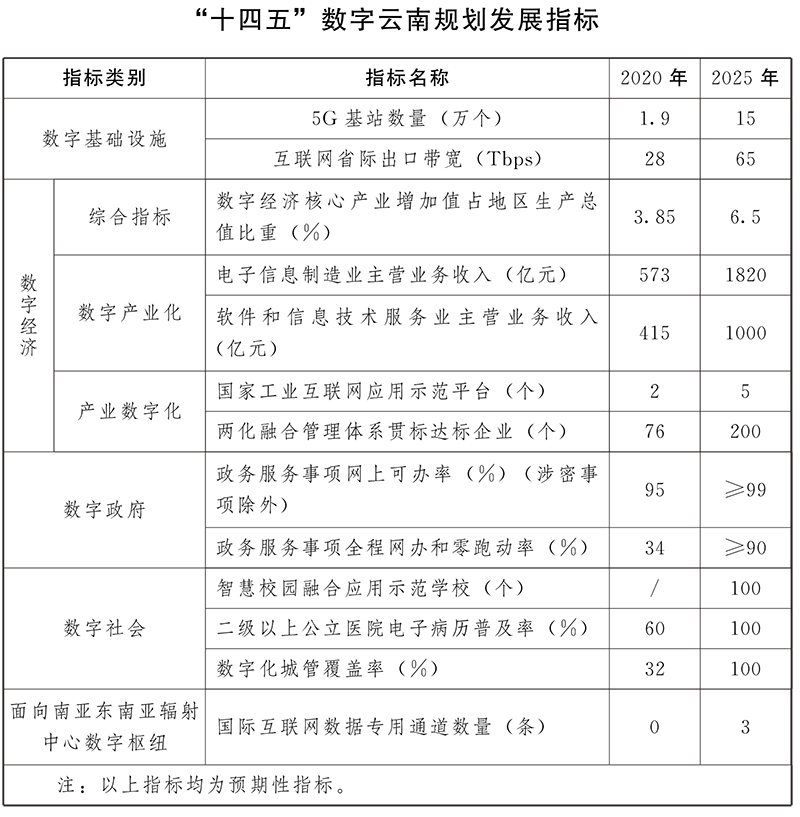
Third, focus on consolidating digital infrastructure
Create high-speed interconnected communication network facilities. We will promote the upgrading and expansion of the province’s urban backbone networks, actively declare the construction of national-level Internet backbone direct connection points, accelerate the proportion of 100-megabit broadband access in the province, and continuously expand the coverage of gigabit fixed broadband access for key areas. Continue to optimize and supplement 4G networks, promote the scale deployment of 5G networks, and promote the coordinated development of 5G and 4 G. Accelerate the deployment of ubiquitous IOT sensing networks, promote the deployment of smart sensors, and support the development of IOT applications. Actively promote the development of satellite remote sensing, communication, navigation and positioning and other related industries, and accelerate the application innovation of the industry.
Promote the scale application of IPv6 (Internet Protocol Version 6). Optimize the performance of IPv6 services, improve the IPv6 service capabilities of cloud service platforms and content distribution networks, and promote data centers and edge clouds to support IPv6. Expand the integrated application of IPv6 industry, focus on the transformation of IPv6 such as e-government extranet, government cloud platform and government website, and actively promote the development of IPv6 application in industries such as industry, agriculture, education, medical care and social security.
Establish an intensive and efficient computing infrastructure. Support the development of green big data centers, accelerate the deployment of computing centers that provide specialized services for artificial intelligence and blockchain technology applications, plan to build high-performance computing infrastructure such as supercomputing centers, explore the construction of international Internet data centers, promote the on-demand layout of edge data centers, and build a computing infrastructure system with balanced layout, collaborative supply and continuous steps. Accelerate the construction of computing infrastructure in key industries such as provincial national defense mobilization potential data centers, and actively strive for the layout and construction of various national data centers in our province. Promote the construction of an integrated big data center system in Yunnan, and guide the intensive utilization and overall layout of data center resources in the province.
Develop open and convenient digital application facilities. Actively build artificial intelligence technology development platform, general ability service platform, professional ability service platform, etc., to support the rapid development and landing of artificial intelligence industry applications. Continue to promote the construction of a safe and scalable blockchain public service platform and service network, support the rapid launch of blockchain applications, and promote the development of blockchain industry in Yunnan.
Fourth, build a collaborative digital government with good governance
With the goal of promoting the reform of digital government, the application demand as the guidance, and the improvement of government service quality and work efficiency as the breakthrough point, based on the information infrastructure such as government cloud, we will accelerate the construction of government informatization and create a government operation and service management model of "one network for collaboration", "one network for management" and "one network for unified management".
(A) Consolidate the basic support capacity of digital government
1. Build an intensive and efficient government cloud.
We will build a provincial-level government cloud and cloud security system, and provide government cloud services and general security services in a unified manner. In principle, all localities and departments will no longer build infrastructure separately, and the established government cloud platforms that do not meet the requirements will not continue to expand in principle. The government affairs cloud should be deployed in a unified way in the province or deployed and interconnected at the provincial, state and city levels. In accordance with the principle of "non-classified systems should be on the top", we will promote the cloud work of government information systems and accelerate the co-construction and sharing of government information systems. Build a disaster recovery backup system of "two places and three centers" in government cloud, and provide highly reliable disaster recovery services for government information systems and data resources. Promote the expansion and expansion of the province’s e-government extranet.
2. Promote the construction of a unified public support platform.
Build a unified identity authentication platform, a unified service integration support platform, and a unified application support platform, strengthen support and relay for various applications, and enhance the coordination and development capabilities of government information systems. The existing government affairs systems of relevant departments directly under the provincial level are connected to relevant platforms after technological transformation, and the newly-built systems are connected according to unified data and business interface standards, so as to encourage the access of state-level government affairs systems. Provincial unified deployment of artificial intelligence, government blockchain and other basic platforms to provide intelligent tools, bottom chain support and perceived data integration. In principle, all localities and departments will no longer build public support platforms separately.
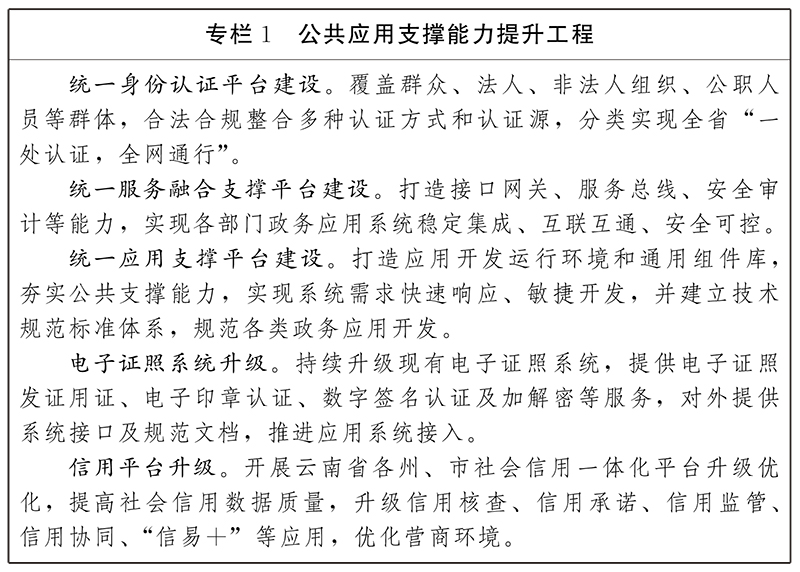
3. Building an integrated government data resource system.
Accelerate the construction and improvement of basic databases such as population, legal person, natural resources and spatial geography, social credit information database and electronic license database, as well as business subject database and relevant special question database of various localities and departments, dynamically update, superimpose and correlate data, and form a multi-dimensional information system of people, things and things. Accelerate the improvement of the trusted data sharing and exchange system, build a unified government data sharing and exchange platform and data resource catalogue, and use data interface to access the platform for non-classified systems built and newly built by provincial departments to accelerate the sharing of various government data. Establish unified data standards for the whole province and data standards for key industries to provide basis for data governance, data management and data analysis. Implement the responsibility of data quality assurance and establish a closed loop of data quality management. According to the responsibilities of the department, the shared data should be used according to the law and regulations, and the management of the whole process of sharing data should be strengthened. Compilation of government data open directory project, the construction of a unified government data open platform, to provide the community with open government data query, download, application interface and other services, to carry out innovative applications.
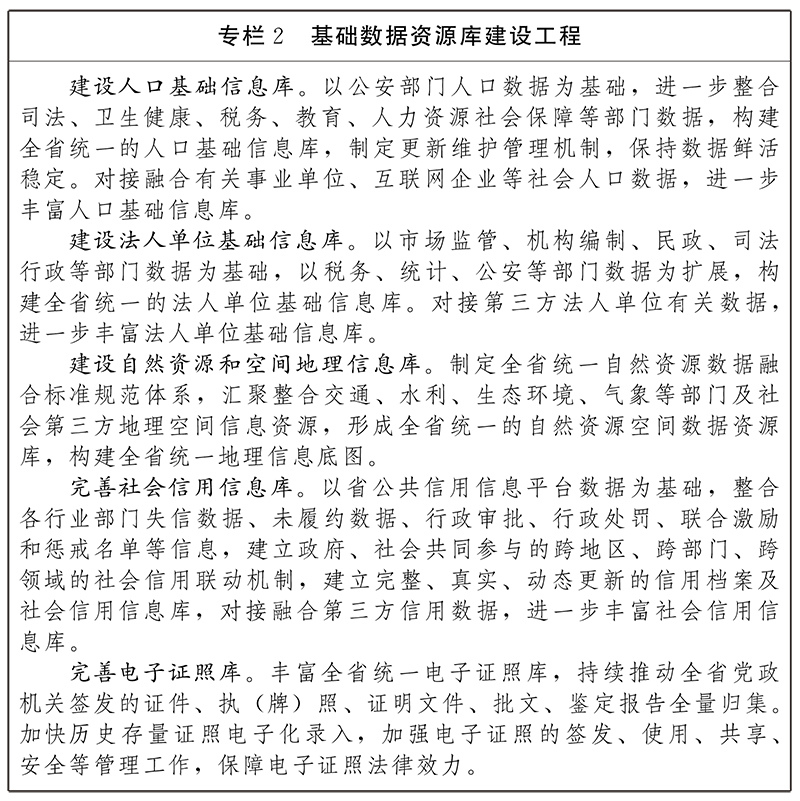
(2) Strengthen the operation of "one network collaboration" by organs.
Improve the digital level of government collaborative office, build a unified government collaborative office platform "Yunzhengtong", support all localities and departments to do documents and work online, serve cross-departmental and cross-level remote meetings, and provide centralized processing, collaborative approval and unified efficiency supervision services for government service matters. Improve the digital level of decision-making and command, accelerate the innovation of government application, support the research and development of various cross-departmental and cross-level applications based on the "Yunzhengtong" platform, and realize the collaborative linkage of departments and the co-construction and sharing of applications. Establish and improve the inter-departmental data sharing application mechanism based on aggregated data, build a government data sharing exchange platform, vigorously promote departments to obtain shared data through the platform, promote business collaboration and process optimization, reduce repeated data collection, and reduce the information burden of the masses and grassroots. Build decision-making command system at different levels, strengthen the government’s scientific decision-making assistance ability, explore research and development decision-making execution simulation system, build analysis models around planning layout, economic regulation and emergency command, and optimize the rationality and accuracy of decision-making. Improve the digital level of administrative supervision, build a dynamic supervision platform for rectification of discipline inspection and supervision, patrol inspection, administrative law enforcement supervision, auditing and other issues, promote the closed-loop control of the whole process of problem discovery and rectification, and realize the whole process of administrative behavior with traces and seals, controllable risks and traceability.
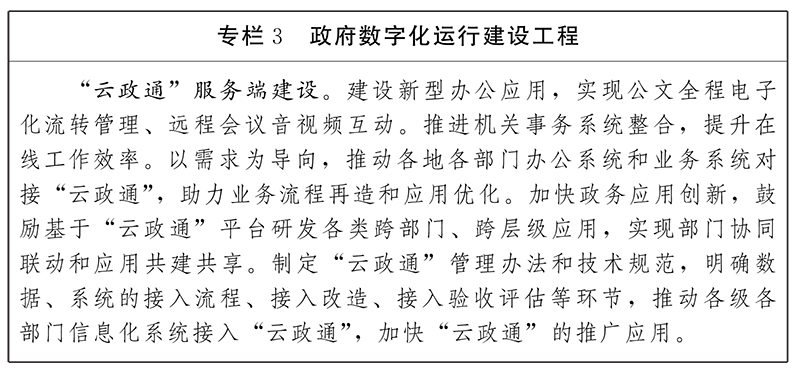
(C) optimize government services "one network to run."
By connecting with Yunnan People’s Society 12333, "One Mobile Phone for Taxes and Fees" and other mobile business systems in various localities and departments, "One Mobile Phone for Services" will be upgraded to become the general portal for the masses and market players to provide one-stop mobile services, and the level of government services for individuals and market players will be improved. Focusing on the people’s daily concerns about the water and electricity network, handling payment, medical treatment, community service and other livelihood hotspots, and promoting the re-optimization of service processes and streamlining of reporting materials. Guided by the sense of acquisition and satisfaction of market participants, we will comprehensively sort out cross-departmental and cross-level enterprise-related services, create enterprise integrated package services, further merge and simplify the handling procedures, promote the consolidation of materials, parallel processes and parallel approvals, and strengthen the province’s online handling and joint handling capabilities through measures such as trusted identity authentication, electronic certificates and data sharing, so as to achieve "Dont Ask For Help, no meeting for approval, and running at most once" for high-frequency government services.
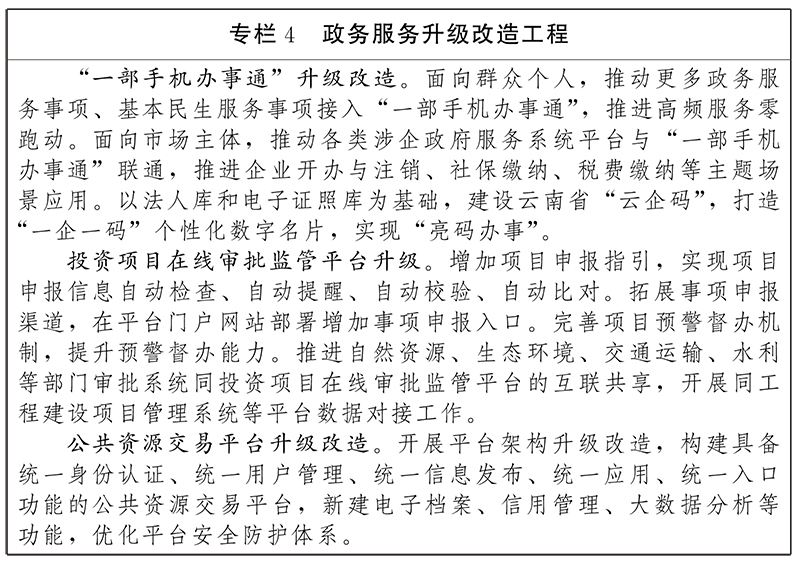
(D) to promote the provincial governance "one network unified management".
1. Improve the ability of digital economy adjustment.
Accelerate the construction of the government’s economic operation regulation system. Focusing on production, consumption, investment, employment, finance, finance, logistics, energy and other key areas of economic operation, we will promote the standardization of economic operation data collection and governance, accelerate the convergence of basic data such as market players, production factors, macro policies, market competition, resources and environment, establish models for economic operation big data analysis, calculation and simulation, carry out economic operation analysis and prediction, and build decision-making command systems at different levels to provide macro-control, industrial policy and risk disposal.

2. Improve the ability of digital supervision and management
Promote the digital transformation of the market supervision system. For key products such as food, medicine, medical equipment and special equipment, we will build a blockchain traceability platform for key food (products) safety information in Yunnan Province, take cold chain logistics, prepackaged dairy products and meat products as breakthroughs, establish a provincial food safety traceability theme database, and build a traceability system with traceable sources, traceable destinations and traceable responsibilities. Promote the docking of social welfare and government supervision information platforms such as bright kitchen and bright factory lines, and accept social supervision. Build an intelligent supervision platform for online take-out, etc. By grabbing the main data from various trading platforms, carry out comparative analysis of the data, and gradually realize effective supervision of online trading platforms, service operators and other online trading service institutions as a starting point, and investigate and deal with illegal acts in online transactions according to law. Vigorously promote the "double random and open" supervision, upgrade and improve the supervision platform, and bring it into the operation of the provincial "internet plus Supervision" system.
Promote the construction of "internet plus Supervision". Upgrade and improve the provincial "internet plus Supervision" system, establish and improve the supervision performance evaluation system, realize the full coverage of supervision objects, the full record of supervision process, the sharing, analysis and early warning of supervision data, and promote the standardization, standardization and accuracy of supervision after the event. Establish a unified publicity platform for law enforcement information in the province, publicize the responsibilities, basis, procedures and results of administrative law enforcement according to law, and accept social supervision.
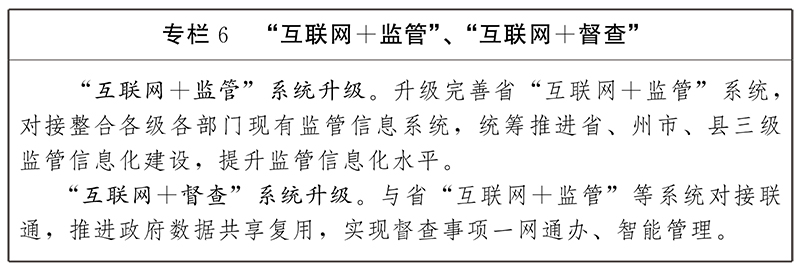
3. Optimize the management ability of digital society
Create a comprehensive management system of intelligent transportation. Promote the simultaneous construction of transportation infrastructure, traffic perception network and communication network, and promote the intelligent transformation of highways, airports and stations. Build a comprehensive transportation operation coordination and emergency command system, and connect with the communication command system, road emergency disposal system and public security traffic police command and dispatch system of highway management units, so as to realize the coordinated application of traffic operation monitoring and emergency response, and promote the closed-loop operation of traffic intelligent emergency command system. Pilot passenger electronic tickets, freight "one single system", etc., and continuously optimize the digital transportation service capacity. Actively carry out technological innovation pilots such as car networking, car-road coordination and driverless driving. Promote the construction of Kunming smart transportation regional radiation demonstration, Baoshan urban-rural integrated smart transportation system demonstration, Yuxi national electronic license plate pilot city, etc., and lead the rapid development of smart transportation in the province.
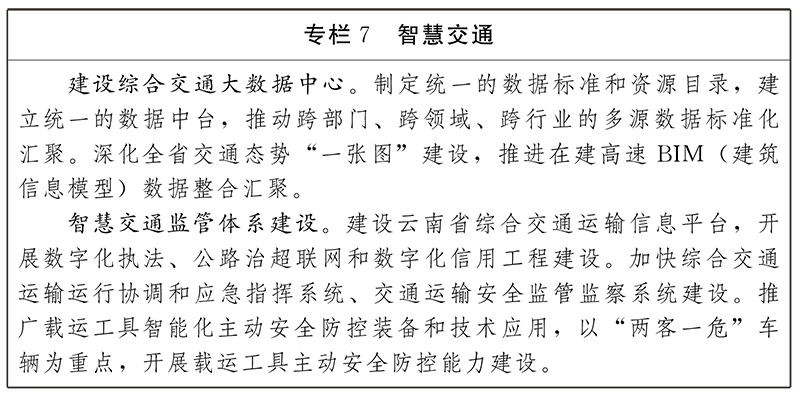
Continue to strengthen the construction of smart emergency response capabilities. Around the safety in production and natural disasters, the province’s emergency communication network will be built to access the communication network resources of relevant units. Integrated Internet of Things awareness, video surveillance and other means, to build a global coverage of emergency awareness network and data collection system, to build a comprehensive application platform for emergency management, to achieve cross-departmental and cross-level business collaboration and information sharing. Around the major risks of safety production in high-risk industries such as non-coal mines, dangerous chemicals, fireworks and firecrackers, as well as natural disasters such as geological disasters, meteorological disasters, floods and droughts, forest fires, etc., a risk monitoring index system and a monitoring and early warning model are constructed to realize comprehensive monitoring of all factors, comprehensive risk assessment, disaster risk early warning and intelligent analysis of disaster situation. Establish an emergency command information system to realize intelligent, flat and integrated command and operation of emergency rescue.

Construct a three-dimensional intelligent comprehensive system of public security prevention and control. Accelerate the construction of public security informatization, build a police cloud application ecosystem and network system, build smart police, build smart public security, and build a smart business application system. Continue to improve the ability of public security prevention and control, and rely on artificial intelligence technology to promote the digitalization, intelligence and efficiency of criminal investigation.
Coordinate and promote the construction of smart border defense. In accordance with the principle of "useful, practical, useful and sustainable", we will focus on strengthening border defense, cracking down on cross-border crimes and epidemic prevention and control, build a digital defense system with intelligent perception, intelligent calculation and intelligent early warning, improve the visualization, digitalization and intelligence of border control, and create Yunnan samples for the construction of smart border defense in China.
4. Strengthen the ability of digital ecological governance
Strengthen the construction of digital ecological environment and supervision system. Build a monitoring network of ecological environment in the whole province to enhance the real-time perception of atmospheric environment, water environment, radiation environment and sound environment. Carry out comprehensive judgment on environmental situation, formulation of environmental policies and measures, prediction and early warning of environmental risks, consultation and evaluation of key work, establish a panoramic model for judgment on ecological environment situation, and improve the decision-making ability of ecological environment management. We will improve the pre-warning and post-event supervision mechanisms, integrate regulatory means such as the rule of law, credit and society, and use data to help improve the effectiveness of supervision. Promote ecological environment information disclosure and online comprehensive information services, build public opinion analysis and guidance services, public information disclosure supervision, one-stop enterprise comprehensive services, and establish a fair, inclusive, convenient and efficient ecological environment public service system. Improve the digital level of ecological environment control, strengthen the automation and intelligent capacity building of environmental pollution control technology, and effectively improve the effect of environmental pollution control.
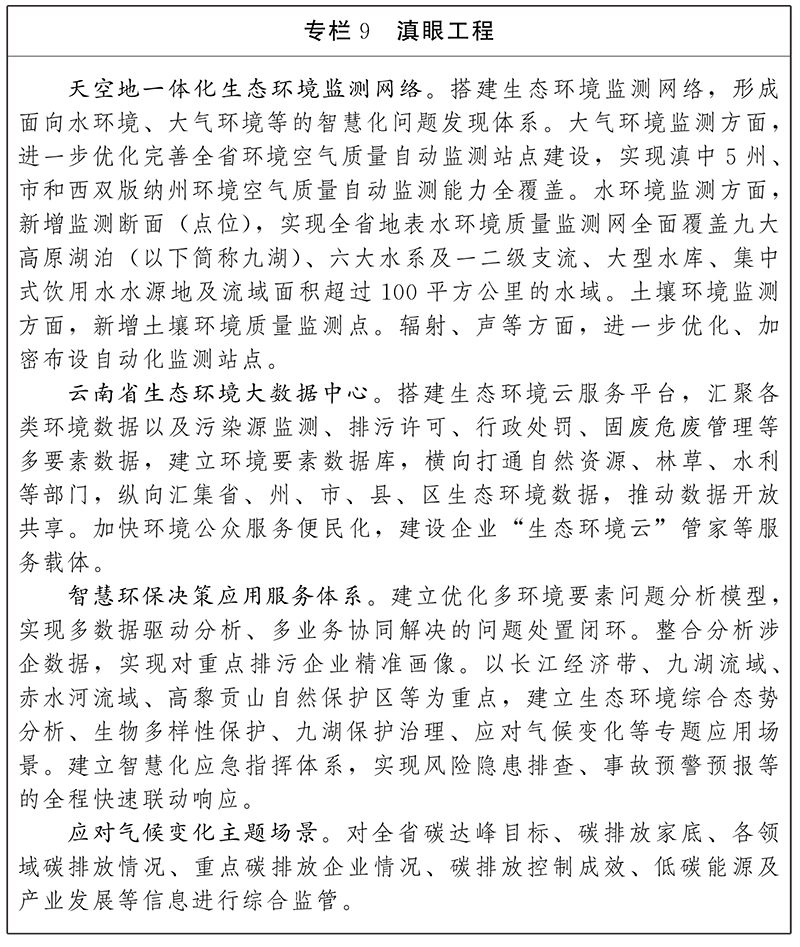
Promote digital management of natural resources. Combined with the results of "multi-regulation integration", we will build a unified big data platform for natural resources and geospatial in the province, and provide time and space benchmarks and "one map" services. Improve the existing spatio-temporal data resources, standardize the spatio-temporal data benchmark of Yunnan Province, and establish a spatio-temporal data management and updating maintenance system. We will build a life-cycle intelligent management and control system for natural resources, and develop natural resources management service applications such as natural resources investigation, monitoring and evaluation, natural resources asset management, land space planning and use control.
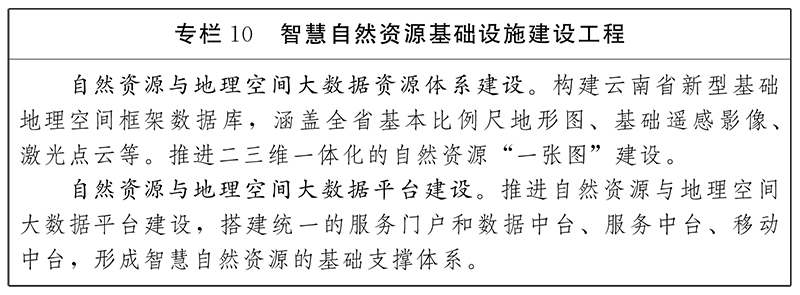
Accelerate the development of digital water conservancy. Improve the water conservancy data collection system, and strengthen the perception of rain, water, engineering, water resources, water environment, water ecology and other related indicators. Build a digital water conservancy big data center, form a data asset management system, and promote cross-departmental sharing and exchange of data resources. Build systems such as "Smart Water Conservancy Dispatching and Supervision System" and "Smart Flood Control and Drought Relief" to provide accurate services for information publicity, disaster early warning and forecasting, public service, supervision and reporting. Accelerate the innovation of smart water conservancy business, promote the application construction of flood control and drought relief, water resources management, water conservancy project management and control, soil and water conservation, river and lake supervision, hydrological monitoring and forecasting, use digital means to support water control, water management and water use, and strive to achieve refined government supervision, integrated river dispatching, intelligent project operation, real-time emergency response, and convenient public services, so as to enhance the scientific and technological support capacity of the water conservancy industry.

Build the engine of digital forestry development. Accelerate the construction of forest fire prevention video monitoring system, and explore the joint application of video monitoring network and other sensing systems. Build applications such as monitoring and evaluation of ecological environment factors, visual decision analysis of monitoring, early warning and prevention of forest and grass pests, and intelligent visual perception to realize regional ecological status analysis and species management. Build a unified spatial basic information system of forest and grass, promote the construction of forest and grass industry service platform, and improve the level of accuracy, refinement, real-time and high efficiency of resource management.
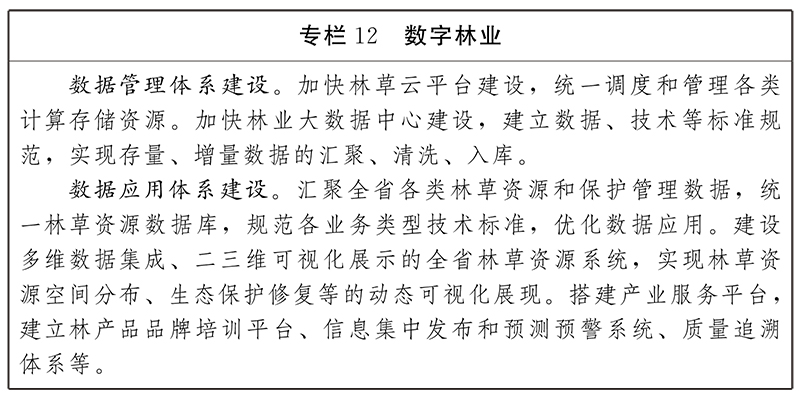
5. Promote the development of wisdom and the rule of law
We will deepen the construction of inter-departmental information law enforcement cooperation between politics and law, and promote the collaborative application of reconnaissance, arrest, prosecution, trial, execution and legal aid. Accelerate the construction of smart courts, improve the ability of traceability management in the whole cycle of handling cases, build a digital system for litigation services, executive command and office handling cases, and explore the judicial application of blockchain such as "cloud evidence room". We will promote innovation in the application of intelligent procuratorial work, explore the single-track collaborative case-handling mode of digital files, and carry out office case-handling applications such as sentencing suggestion assistance and criminal execution procuratorial intelligence assistance. We will develop intelligent justice, promote the construction of intelligent application systems such as intelligent law enforcement supervision, intelligent notarization, intelligent mediation, and intelligent assessment, and enhance the comprehensive service capabilities of governing the province according to law, administrative legislation, administrative law enforcement supervision, criminal execution and emergency command, and public legal services.
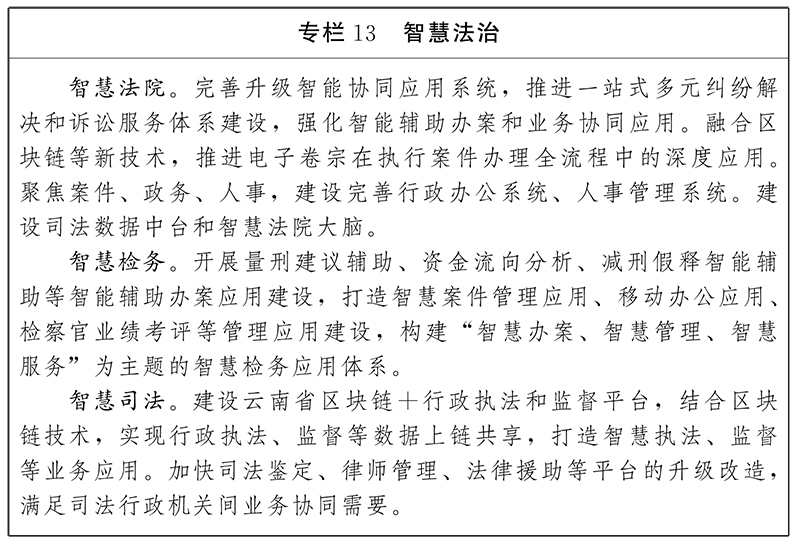
6. Accelerate the wisdom of party building.
Relying on the "Yunling Pioneer" APP, we will promote the deep integration of modern information technologies such as the Internet, big data and artificial intelligence with party building work, and integrate party affairs management, party building supervision, party member education, party building publicity and people’s livelihood services, so as to realize the digital tracking of the whole process of party member and party organizations. Build a smart party building support system, upgrade and improve the "Party Building Cloud" infrastructure, and integrate data resources of grassroots party building, cadre management, civil servant management and talent work modules based on databases such as intra-party statistics, cadre (civil servant) statistics and talent statistics. Effectively accelerate the construction and application of the "four modules" of grass-roots party building, cadre management, civil servant management and talent work, promote the mutual integration and application of the "four modules" data, provide real-time and high-quality data sources, build a smart data brain for party building, and realize standardized management, three-dimensional application and scientific decision-making of party building work.
V. Vigorously develop the digital economy
Guided by application, we will expand application scenarios, promote the construction of enterprises’ access to the cloud and industrial Internet, accelerate the digital transformation of agriculture, manufacturing, energy, logistics, tourism and other industries, promote the "access to the cloud to give wisdom", and realize the integrated development of digital economy and real economy. Vigorously develop the core industries of digital economy such as electronic information manufacturing, software and information technology services, and support the digital development of industries.
(1) Deepening the digital transformation of key industries
1. Accelerate the digital transformation of agriculture
Guide the wide application of digital technology in the whole process of agricultural production, promote the superposition of various data such as agricultural soil, climate and industrial distribution on one map, and realize the whole life cycle data sharing of agricultural products. Encourage enterprises to develop digital agricultural characteristic applications such as tea, flowers, fruits, vegetables, nuts, coffee, Chinese herbal medicines and beef cattle, and build a number of agricultural and rural information demonstration bases, smart agricultural industrial parks, smart farms and smart agricultural logistics distribution centers. Vigorously develop rural e-commerce, establish green agricultural products online sales, supply chain coordination, anti-counterfeiting traceability and other systems, promote the digital upgrading of the whole chain from planting, breeding, procurement, sales to traceability, and comprehensively enhance the added value of agricultural production, processing and sales. Support enterprises to innovate cooperation models, fill the shortcomings of farmers’ use of digital technology, continue to expand the sales market of agricultural products, fully tap the value of agricultural products, and drive farmers to increase their income and become rich.
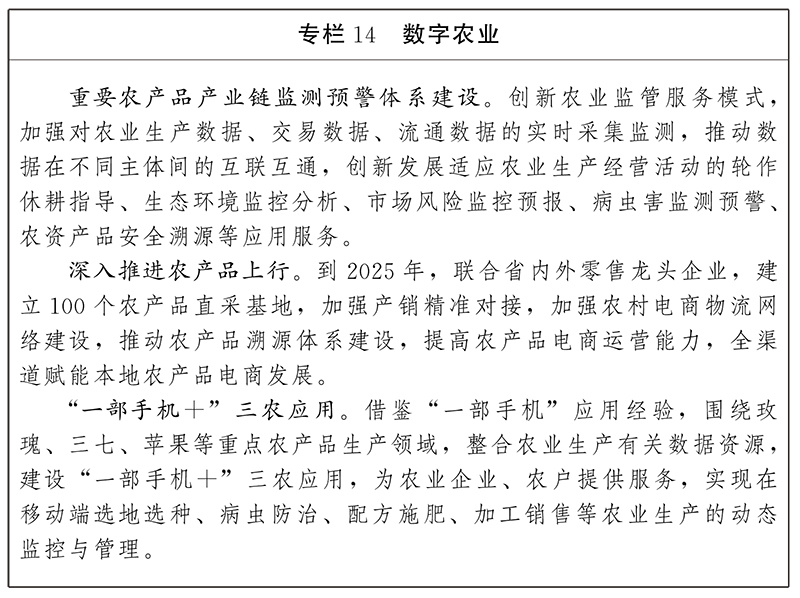
2. Create a digital development engine for green energy.
Establish and improve the energy Internet covering the whole industrial chain. Vigorously develop smart grid, promote the construction of smart grid demonstration area in the province, improve the regulation and flexibility of power grid, and ensure the safety and stability of power supply and power grid. Encourage key power generation enterprises in the province to deploy power production site communication networks and promote the construction of digital application of power production. Guide electric power enterprises to develop digital power dispatching, transmission and distribution system, promote intelligent transformation and upgrading of distribution equipment, and realize integrated monitoring, early warning, analysis and decision-making of large power grid. Strengthen the digitalization of government energy management and decision-making, build services such as comprehensive energy operation analysis, safety supervision, and "one mobile phone to handle affairs" handheld energy module, and improve energy governance and public energy service capabilities. Strengthen the construction of digital natural gas safety supervision capacity, and focus on the application construction of state monitoring, leakage alarm and intelligent inspection of natural gas transmission equipment and pipelines.
Promote the development and utilization of smart energy big data collection. We will build an energy data transmission network connecting the relevant departments of China, provinces, prefectures and cities, as well as relevant enterprises such as electricity, coal, oil and gas, and build an extensible Yunnan green energy big data center to support the application and construction of energy data. Create "internet plus Energy" public service, and improve the level of one-stop services such as smart energy use. Establish an energy supervision and management network system covering the whole chain of energy production, circulation and consumption, and support the government to carry out energy planning and decision-making, macro-control of energy, energy security, energy industrial structure adjustment, etc.
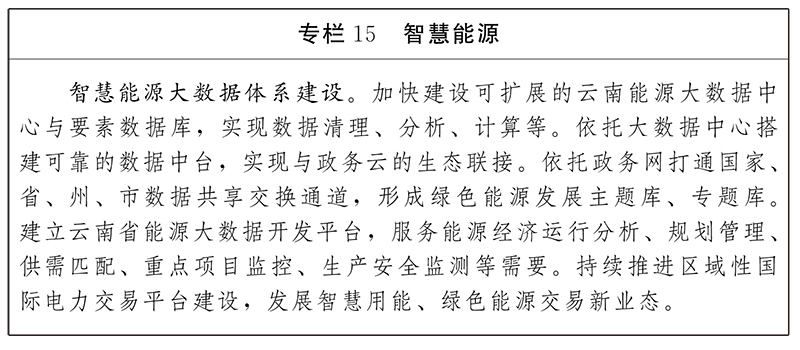
3. Deepen the development of smart tourism services.
Continue to deepen the development of smart tourism. Continue to optimize and upgrade "a mobile phone to visit Yunnan" and promote the construction of a comprehensive service system for culture and tourism. Accelerate the construction of smart tourism information infrastructure, achieve full coverage of smart tour guides, electronic explanations, face-brushing authentication and other services in tourist attractions, star-rated hotels, tourist concentration areas and state-level public cultural service places in the province, accelerate the deployment of 5G in key tourist core areas, and create the application of "5G+ smart tourism". Focusing on Dali Ancient City, Old Town of Lijiang and Yulong Snow Mountain, we will build a national model of smart tourist attractions. Create smart tourism transportation services such as car rental and chartered car, open up the "last mile" of scenic traffic, and promote seamless docking, zero-distance transfer and efficient connection between major transportation hubs in the province and key tourist cities and scenic spots. Accelerate the establishment of a smart tourism standard system and statistical system, build a comprehensive management system for cultural and tourism visualization, and realize digital service management such as comprehensive market law enforcement, credit construction of market entities, and acceptance and disposal of tourists’ complaints.
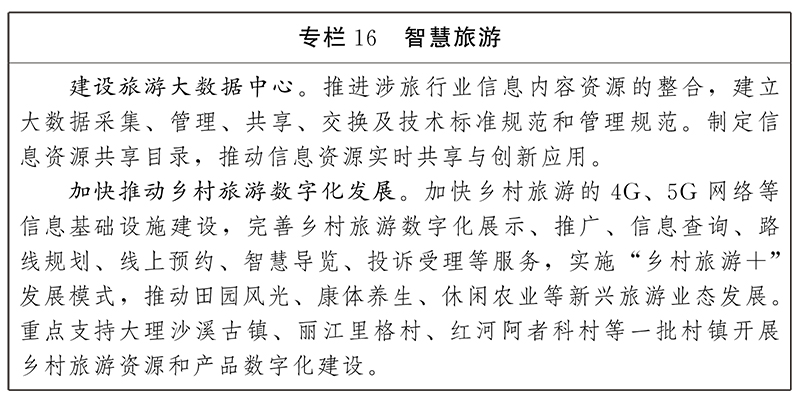
Accelerate the development of smart health care industry. Promote the deep integration of digital technology and health care industry, guide medical institutions for the aged to increase the application of assistive technology products for the elderly, and establish and improve the health service system for the elderly. Accelerate the development of the combination of medical care and nursing, and strengthen the standard construction of rehabilitation treatment centers and nursing centers.
4. Promote the high-quality development of intelligent manufacturing.
Promote the construction of industrial Internet networks and platforms. Encourage enterprises to carry out the transformation and upgrading of internal and external networks, accelerate the deployment of 5G networks to key industrial parks and enterprises in key industries, and vigorously develop the "5G+ Industrial Internet". Construction of key industries and key areas of industrial Internet logo analysis secondary nodes, and promote the collaborative application of industrial Internet platform and logo analysis. Guide leading enterprises and Internet companies in the industry to build industrial Internet application platforms and public service platforms with regional and industrial characteristics, and cultivate industrial Internet applications such as R&D, design, manufacturing, operation and maintenance services and operation management.
Promote the digital transformation of manufacturing industry. Implement the enterprise digital transformation project, support enterprises to carry out the construction of 5G fully connected factories, digital production lines, digital workshops and digital factories, and build fully digital benchmark demonstration enterprises in key industries. Encourage small and medium-sized enterprise business systems to migrate to the cloud, improve the efficiency of enterprise operation and management, and reduce the cost of enterprise information transformation. We will further promote the integration of enterprises’ industrialization and informatization, establish an evaluation system of enterprises’ digitalization ability, and strengthen the guidance on the implementation of the management system of enterprises’ industrialization and informatization. Encourage key enterprises in key industries to speed up process reengineering and business innovation, and develop new modes and formats such as joint R&D innovation, collaborative manufacturing, personalized customization and service-oriented manufacturing. Focus on promoting the digitalization of the whole tobacco industry chain, building "digital tobacco fields", "digital workshops" and "digital factories" to build Industry 4.0 digital tobacco.
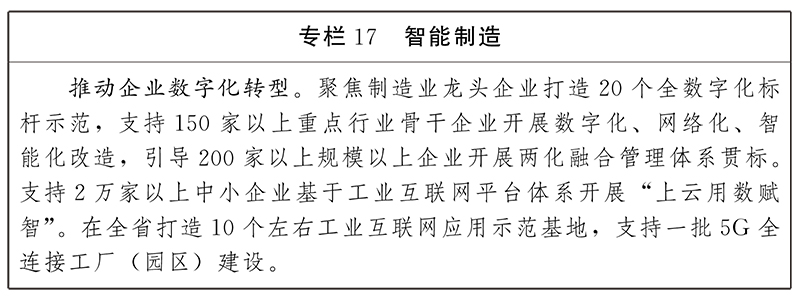
5. Deepen the digital development of service industry.
Accelerate the digital innovation of logistics industry. Implement smart logistics project, encourage the transformation of traditional logistics information platform to logistics supply chain platform, focus on cultivating 10 smart logistics information platforms, and improve the intelligent management level of transparent, visible and traceable logistics process. Actively build logistics information systems in key areas such as international transportation, multimodal transport, cold chain transportation and rural logistics, and promote the coordinated development of production, consumption and e-commerce logistics. Strengthen the supervision of smart logistics information, build a comprehensive logistics big data operation monitoring and analysis system, connect with the national logistics information platform, access logistics hubs, logistics enterprises and related data resources, comprehensively and accurately grasp the operation status of transportation logistics industry, and provide one-stop information services for cross-regional and inter-departmental logistics public information.
Vigorously develop smart finance. Actively strive for the pilot demonstration construction of digital RMB and promote the application and promotion of digital RMB. Expand corporate financing channels and encourage banking institutions to continue to promote the pilot and promotion of digital financial services such as intellectual property pledge and supply chain financing. Support the integration and innovation of traditional finance and new finance, and accelerate the digital transformation of inclusive finance and green finance. Actively carry out the work of "easy credit" and complete the development and deployment of the comprehensive financing service platform for small and medium-sized enterprises in Yunnan Province. Develop online financial services and promote services such as intelligent investment consultants.
6. Comprehensively improve the supply of public services for digital transformation of enterprises.
Accelerate the construction of the province’s digital transformation inclusive service system, further promote the action of "using numbers to empower wisdom", and encourage platform enterprises to provide digital transformation services for core business links such as R&D design, operation management, production and processing, logistics after-sales and data analysis. Establish a linkage mechanism between government, financial institutions, platforms and small and medium-sized enterprises to provide low-cost and high-quality digital transformation service products for small and medium-sized enterprises and flexible employees.
(B) accelerate the development of digital industrialization
Promote the large-scale development of electronic information manufacturing industry. We will continue to cultivate and introduce enterprises and major projects, focus on promoting the R&D and production of high-end servers, new smart phones, intelligent function machines for specific groups, service robots and other products, develop the production and manufacturing of consumer smart wearable devices such as smart bracelets, smart watches, smart anti-loss devices and smart glasses, promote the industrial layout of GPU board production, Internet of Things sensor manufacturing and so on, and continue to introduce the whole machine manufacturing project of Xinchuang. Develop optoelectronic display materials and devices, infrared and ultraviolet detector materials, anode and cathode materials and diaphragm materials of new lithium ion batteries. Accelerate the development and production of new generation display technology and key semiconductor materials.
Accelerate the development of emerging frontier industries. Expand Yunnan’s 5G industry, give priority to weaving the 5G networks in Kunming, Qujing and Yuxi, implement the "Sailing" plan for 5G applications, create new products, new formats and new models for 5G converged applications, and promote the innovative applications such as "5G+" information consumption, industrial Internet, smart logistics, smart power, culture and tourism. Relevant standardization organizations in the United Nations and leading enterprises in local industries actively carry out research on the application standards of 5G convergence in key industries to promote the application of the industry. Promote the development of artificial intelligence industry, and accelerate the research and development and industrialization of key technologies such as computer vision, intelligent voice processing, biometric identification and natural semantic understanding. Relying on the blockchain center of Yunnan Province, we will accelerate the development of blockchain industry agglomeration and build a number of competitive blockchain products with independent intellectual property rights. Do a good job in the software and information technology service industry, and support the development of system integration, operation and maintenance, software outsourcing, industrial application software and solutions. Build an application software development and service ecosystem based on an autonomous and controllable basic platform, and promote the research and development and industrialization of industrial software and industrial application software. Develop satellite application industry, unite key enterprises and scientific research institutes, and cultivate satellite application service market.
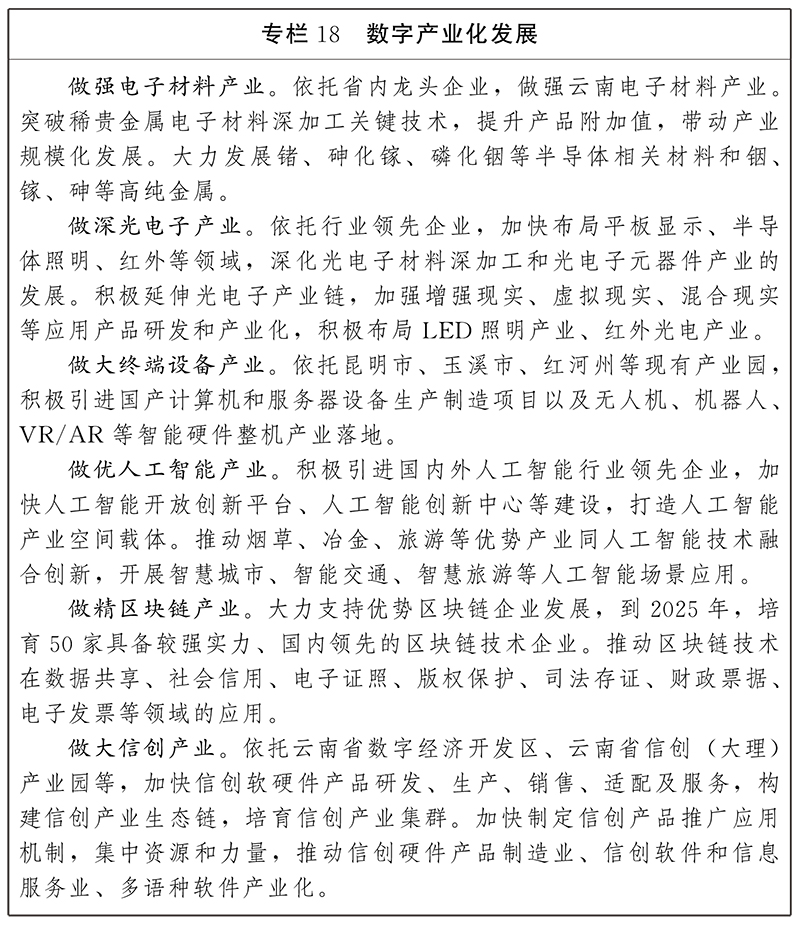
Planning industrial layout and constructing new ecology of industrial development. Eliminate backward production capacity, promote the optimization and upgrading of the park, support digital economy enterprises to gather in national high-tech zones and national economic and technological development zones, formulate supporting policies for digital economy enterprises that have settled in the park, accelerate the development of digital industry agglomeration, and cultivate a number of provincial digital economic parks. Focus on electronic materials, intelligent terminals, software development, etc., accurately formulate special support policies and investment catalogues of key enterprises, innovate the "government+investment platform+leading enterprises" industrial investment promotion and park operation mode, actively carry out industrial chain investment promotion, guide industrial agglomeration through market-oriented methods, and cultivate and introduce a number of leading enterprises with certain influence in the country.
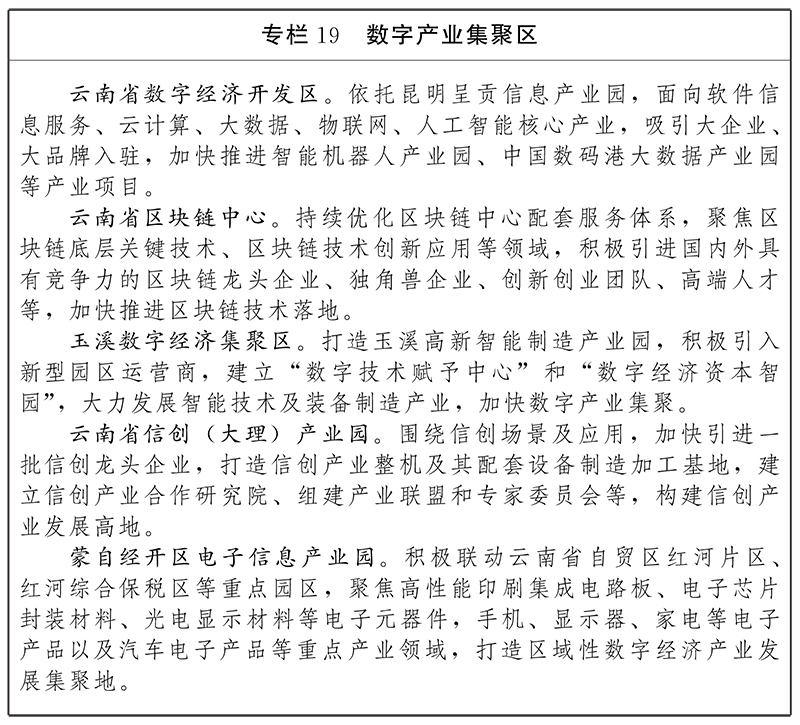

Promote the development of new industries, new formats and new models. Develop a platform economy, support the use of modern information technologies such as the Internet, the Internet of Things and big data, and build a cross-regional and cross-domain platform to provide transactions and services for bilateral or multilateral users in combination with advantageous industries such as plateau agricultural products and characteristic cultural and creative products in our province. Actively introduce and cultivate online entertainment subjects, tap Yunnan’s characteristic entertainment resources, and encourage the development of live broadcast, VR/AR and other formats. Promote the innovation of exhibition format, and rely on the new online exhibition platform represented by the digital platform of South Expo to hold a "cloud exhibition" and carry out a series of activities such as "cloud display", "cloud docking", "cloud negotiation" and "cloud signing". Expand the retail format of fresh e-commerce, build online supermarkets, smart micro-food markets, unmanned supermarkets, etc., expand the coverage of "non-contact" distribution, and speed up the layout of smart lockers, insulated take-out cabinets, terminal distribution service stations and convenient facilities such as self-delivery points in communities, parks and buildings. Actively lay out new formats of online education, strengthen the research and development of excellent online course resources, and guide the normal integration and development of online and offline education.
(C) Strengthen digital technology and application innovation
We will further promote the construction of national and provincial innovation platforms, tackle key core technologies of rare and precious metals such as germanium, arsenic, indium and platinum group, and promote the deep integration of industrial chain and innovation chain. Strengthen the construction of technology application research and development system, vigorously promote the application innovation of digital technology in the industry, and encourage the construction of industrial innovation carriers such as laboratories, key laboratories and engineering (technology) research centers, enterprise technology centers and professional incubators in Yunnan Province around key industrial fields such as 5G, blockchain, digital agriculture, intelligent manufacturing and smart tourism, and promote the construction of supporting capacity such as public testing, software evaluation, network testing and technical standards. Support leading enterprises, universities and research institutes to jointly establish a platform for normalized personnel training and technological innovation cooperation. Establish and improve the statistical reporting system and intangible assets management system for the transfer and transformation of scientific and technological achievements, and establish and improve the evaluation system for scientific and technological achievements. Support the construction of technology transfer institutions and build a platform for technology transfer and achievement transformation.
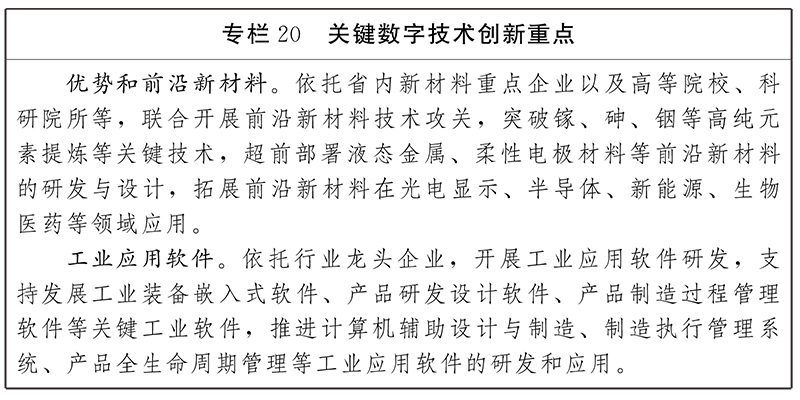
Sixth, build a convenient and inclusive digital society
Comprehensive use of big data, artificial intelligence, blockchain and other technical means, accelerate the construction of an intelligent service system in the field of people’s livelihood, promote the construction of basic support capabilities such as medical care, education, pension and government assistance, and create smart services that benefit the people and facilitate the people. Accelerate the construction of digital villages around key areas such as rural infrastructure, rural governance and rural services for the benefit of the people. Taking the actual needs of urban development as the starting point, we will promote the construction of digital cities in the province. Focus on building a beautiful digital life, promote the construction of smart communities, further promote digital home applications, and enhance citizens’ digital literacy.
(A) to promote the digitalization of public services
Improve the digital service ability in the field of health. Accelerate the construction of one-code communication system for medical treatment in the whole province, realize the one-code communication of residents with codes (cards) and the collection and access of medical information, and improve the convenience of diagnosis and treatment. In accordance with the unified standards, we will continue to promote the interconnection of provincial, state and municipal national health information platforms, build a cloud imaging center in Yunnan Province, realize the collection, storage and shared access of image data (digital films) of secondary and above hospitals in the province, and reduce the cost of patient diagnosis and treatment. Expand the application of big data, cloud computing, artificial intelligence, blockchain and other technologies in medical image data mining and auxiliary diagnosis, focusing on primary health institutions and improving the diagnostic level. Construction of disease prevention and control information system (digital disease control platform), immunization planning and vaccine traceability system, maternal and child health care information system and emergency command system for sudden major public health events, open up key data collection channels for medical and public health, promote cross-regional and cross-departmental sharing of health care big data, and strengthen medical and prevention coordination. Create a smart medical insurance platform, establish data analysis capabilities such as fund operation, off-site settlement, supervision and inspection, and strengthen supervision, monitoring and early warning analysis of medical insurance funds.
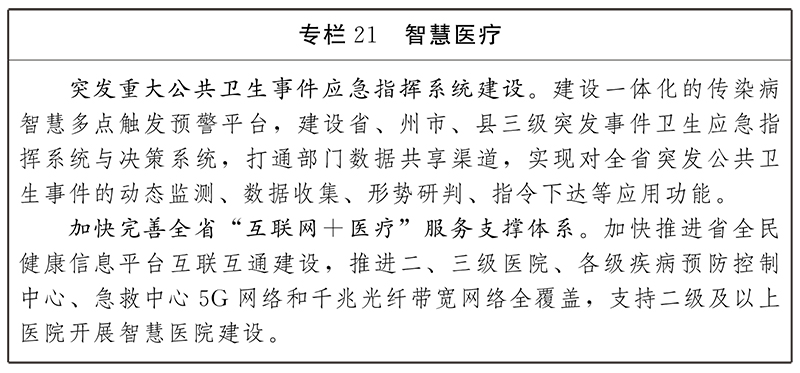
Increase the ability supply of wisdom education. In-depth implementation of the education informatization 2.0 action plan, the implementation of the "education on the cloud" project, the integration and construction of excellent parenting resources, and the synchronization of urban high-quality teaching resources and classroom teaching to rural schools. Construct a big data precision teaching classroom in primary and secondary schools, and construct the optimal learning path for students by collecting the whole scene process dynamic data and combining the regional subject knowledge map. Promote the application of intelligent learning terminals in primary and secondary schools, and gradually realize that all students have intelligent learning equipment. Promote the development of online education, promote the integration of high-quality online course resources into the public teaching system, gradually narrow the digital gap between regions and urban and rural areas, and vigorously promote educational equity. Integrate high-quality resources inside and outside the education system, carry out the construction of high-quality digital resource base matching with teaching materials in the field of basic education, introduce high-quality social courses, build an educational resource sharing system, and expand the coverage of high-quality educational resources. Build a smart education cloud platform in the province, promote the construction of educational digital platforms and applications such as daily activities teaching and management services for children, mathematics, music and art teaching for primary schools, enrollment management for primary and secondary schools, physical examination management for junior high school students, English listening and speaking service and examination, and professional evaluation for undergraduate colleges and universities, and promote the modernization of educational management, scientific decision-making and networking of services, so as to improve the quality of education by digital means.
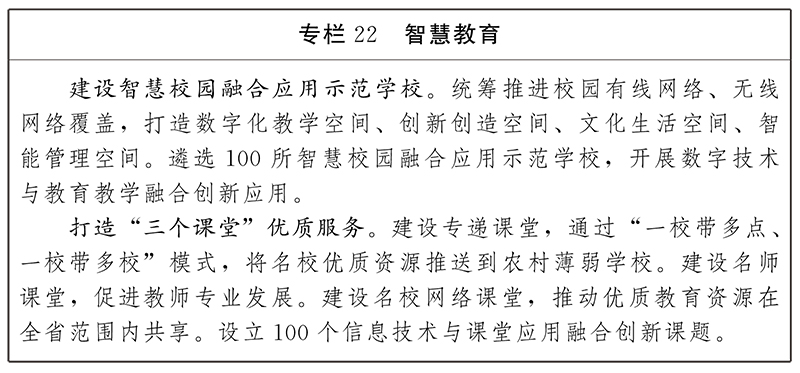
Constructing the service system of digital people’s society. Accelerate the digital transformation of human society, promote cross-level and inter-departmental data sharing and business collaboration, and realize the horizontal and vertical integration of all business platforms, data and services of human society. Promote the full-service network of people’s society and create a public service channel for people’s society based on online management. Improve the unified Yunnan People’s Society 12333 public service portal and innovate the handling service system. Promote the application of social security cards in the field of social services, promote the application of electronic social security cards, provide real-name authentication for login links of related application systems, and simplify the registration process.
Promote the upgrading of digital civil affairs services. Accelerate the intelligent transformation of low-income services, accelerate the application of technologies such as face authentication, fingerprint collection and electronic signature, continuously expand the scope of online services, integrate social assistance, education security, medical security and other services, and build a smart rescue service system with "one mobile phone to run low-income services" as the core application. Upgrade the back-end handling system of online services, create a humanized front-end window of online services, optimize the online service environment, ensure the personal information security of clients, and build a service model of "open platform+multiple services+unified standards".
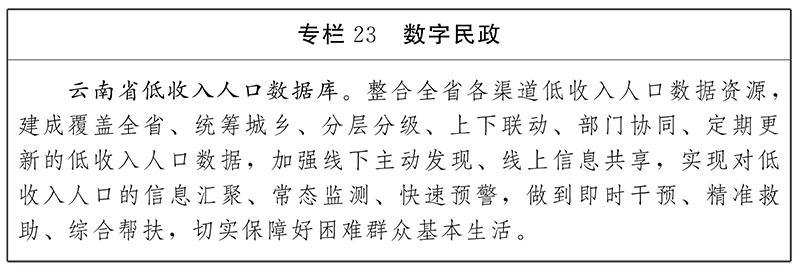
Develop the service of intelligent veterans. Promote the construction of a unified service system for smart retired military personnel in the province, and form a new pattern of work for retired military personnel in the province with online and offline integration, orderly service connection, standardization, safety and efficiency. We will build an integrated service platform for retired military personnel, establish a service platform for retired military personnel, a comprehensive affairs management platform, a service center management platform, an operation management platform and a smart governance platform in internet plus, and improve the business governance ability and service level of retired military personnel.
Create a digital cultural service system. Promote the construction of smart radio and television, and build an interconnected smart radio and television fusion media cloud. Encourage Yunnan Daily Newspaper Group, Yunnan Radio and Television Station to build public cultural infrastructure such as Cloud Smart Cloud, Cloud Cultural Cloud and Colorful Cloud.
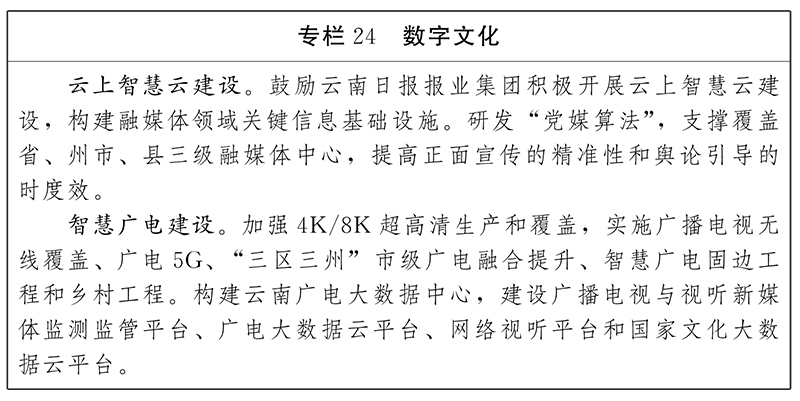
(2) Promote the construction of digital villages and digital cities.
1. Digital rural construction
Use digital means to comprehensively consolidate and expand the achievements of poverty alleviation. Create a unified government assistance platform in the province, fully cover the rural low-income population, build a low-income population resource pool and a village-level collective economic assistance and assistance information platform, collect data in the fields of subsistence allowances, employment, housing, drinking water safety, education, medical care, etc., and explore various ways of assistance to ensure that eligible people in need receive timely assistance. Accelerate the establishment of a dynamic monitoring and management system to prevent poverty from returning to poverty, integrate all kinds of relief services in the province, accurately depict the portraits of helpers, and respond efficiently to the people’s relief demands. We will build a digital management system for ex situ poverty alleviation and relocation, collect all-round data and dynamically update the centralized resettlement sites, relocated households and relocated population, realize the co-construction and sharing of data and information, and do a good job in accurate management and follow-up support.
Improve the information service system for benefiting farmers. We will promote the construction of Yunnan government service network, "one mobile phone to handle affairs" and a comprehensive service platform for grassroots party organizations, accelerate the full coverage of online government services in rural areas, and get through the "last mile" of serving the masses. Promote the development of education, medical care and health care in rural "internet plus" and improve the level of rural public services. Build a digital agricultural rural service system, coordinate the province’s agricultural information and data, and encourage the development of agricultural productive services in the fields of market information and agricultural materials supply. We will fully implement the project of information entering villages and households, carry out in-depth cloud promotion and cloud training, promote the "Yunnong 12316" information service platform, promote the construction of "Yi Nong Information Society", and promote the comprehensive docking and smooth flow of urban and rural resources.

2. Digital city construction
Consolidate the infrastructure of digital cities. Accelerate the digital transformation of urban infrastructure, focus on industrial parks, urban road networks, street communities, etc., promote the co-construction and sharing of front-end equipment such as sensors and cameras and transmission networks, and form a new generation of intelligent infrastructure system with "cloud, network and terminal" as the core. Explore the construction of urban elements database, and collect urban elements information covering urban topography, landforms, roads, houses, water plants, power plants, underground pipe networks and so on through the front-end perception system.
Strengthen the application innovation of digital city. Promote the refinement of urban management, accelerate the construction of digital urban management platforms, formulate data standards, standardize the construction and operation of platforms at all levels, build urban grid management, joint law enforcement command and dispatch systems, and carry out real-time monitoring of urban drainage networks and natural gas pipelines. States, cities, counties, and districts are encouraged to carry out urban application innovations such as smart sanitation, smart urban management, smart public transport, smart parking, smart license plates, and smart farmers’ markets according to their own development needs. Promote the construction of digital management systems for urban buildings, municipal facilities and underground pipelines, monitor and perceive the operation of building facilities in real time, and scientifically design and rationally plan the layout of urban public infrastructure.
Build the core center of digital city. Focusing on data collaboration, technology collaboration and business collaboration, we will formulate unified data standards, interface specifications and call rules, and gather data on government services, urban governance, and benefiting enterprises and people. Establish basic databases such as population database, legal person database, geographical database and urban essential database, promote the comprehensive docking of resource data of various departments with basic databases, and realize accurate analysis of urban operation through real-time updating and dynamic superposition of data. Encourage all localities to focus on pain points and difficult problems, carry out pilot projects of typical application scenarios, develop personalized and characteristic application scenarios, improve urban governance capacity and level, and promote urban governance from digitalization to intelligence. Pilot construction was carried out in Kunming, Dali, Lijiang, Yuxi, Baoshan and Pu ‘er. After summing up experience and forming a unified technical standard, it was promoted throughout the province.
(3) Building a beautiful digital life
Innovative and intelligent community service. We will build network facilities and intelligent terminals in qualified communities, deepen the application of community grid digital management mode, continuously improve the online diversified solution platform for contradictions and disputes, and effectively improve the ability of grassroots contradictions and disputes. Encourage community service enterprises to build a convenient comprehensive property service system, promote the application innovation of property management and housekeeping services, and develop services such as community wisdom for the aged and childcare. Open up the "last mile" of logistics and distribution, and develop services such as express delivery point, express supermarket and intelligent express box.
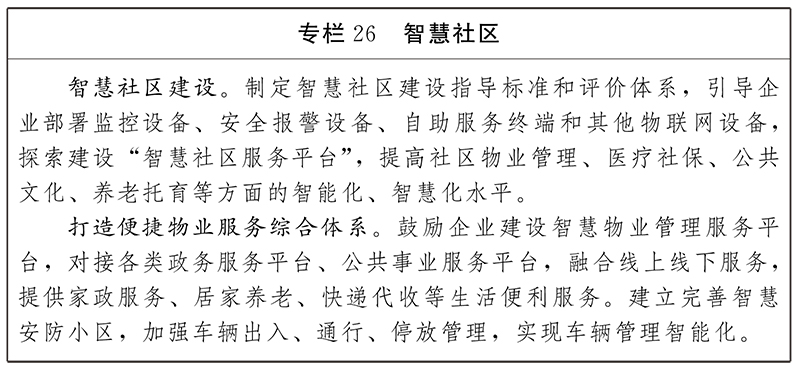
Promote digital home applications. Encourage smart terminal manufacturers to speed up the research and development, manufacture, promotion and application of smart home products, innovate and diversify the operation methods of smart home products, and build a new experience of digital life. Promote the sharing of digital home information resources with smart communities and smart property management. Actively guide communities and enterprises to carry out smart home product experience, application training and other activities to improve residents’ ability to use smart home products. Continue to study and focus on solving the ethical, moral and safety problems brought about by the application of artificial intelligence technology.
Improve citizens’ digital literacy. Strengthen the digital training of civil servants, improve the digital literacy of civil servants, especially leading cadres, and improve the ability to use digital technology and innovation. Improve the digital ability of urban workers, improve the digital skills training system for enterprise employees and industrial workers, and cultivate the digital industry talent team. We will carry out training in the promotion of new technologies in agriculture and rural areas, e-commerce sales and the application of new media, build a modern agricultural science and education information service system, and continuously improve farmers’ informatization skills and level.
Improve the construction of digital inclusion. Strengthen the supply of digital services for specific groups such as the elderly, the disabled, residents in remote areas and ethnic minorities, encourage enterprises to develop and design barrier-free intelligent terminal equipment, websites and mobile Internet applications, strengthen the optimization and upgrading of high-frequency services such as "Yunnan Health Code", bus and subway rides, and appointment registration, increase the research, development, application and promotion of minority language and voice technology, and eliminate obstacles in service charges, terminal equipment, services and applications.
Seven, build a digital hub for South Asia and Southeast Asia Radiation Center.
Around the digital hub facing South Asia and Southeast Asia Radiation Center, we will build cross-border digital infrastructure, build an international communication hub and industrial cooperation platform, promote the digital development of cross-border trade, cross-border logistics and cross-border finance, vigorously develop cross-border electronic commerce, promote international cooperation in cross-border digital economy, and build a strategic core hub of digital Silk Road.
(1) Building cross-border digital infrastructure
Optimize the layout of Yunnan’s international network, promote the Kunming regional international communication service import and export bureau of China Telecom, China Unicom and China Mobile to upgrade to full service, promote the expansion of international export bandwidth, build China’s international information channel connecting South Asia and Southeast Asia, and gather international communication services between China and South Asia and Southeast Asia countries. Support Kunming to build a dedicated channel for Internet data and promote the agglomeration of export-oriented industries. Accelerate the digital construction of China (Yunnan) Pilot Free Trade Zone, and build a one-stop comprehensive service system including e-commerce supervision, supply chain and living facilities.
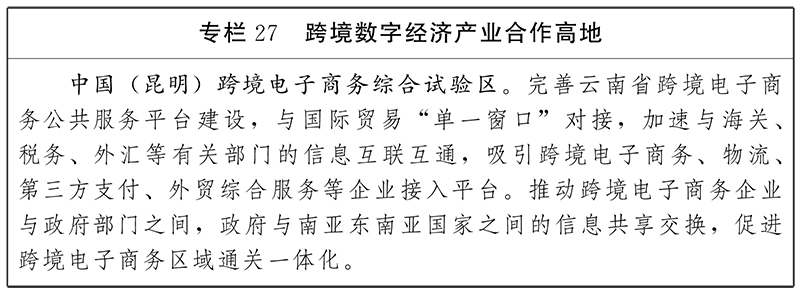
(2) Promoting cross-border cooperation in the digital economy
Construct an efficient intelligent comprehensive system of cross-border logistics. Actively promote cross-border electronic commerce’s ability to import and export goods and services. Relying on the construction of China-Laos Railway and China’s Great Corridor around the Indian Ocean, we will create intelligent cross-border logistics services and make overall plans to solve the problems of transportation, commerce and regulatory services. Focus on important ports such as Hekou, Ruili and Mohan, speed up the intelligent construction of ports, promote the exchange and sharing of intermodal logistics information, and realize the visual application of port customs clearance logistics information and the detection and early warning of abnormal information. Encourage and support enterprises to build a cross-border logistics public information platform for South Asia and Southeast Asia, and gradually realize the interconnection and sharing of international logistics information in the region.
Deepen the development of cross-border electronic commerce. Improve the support and incentive policies, recruit cross-border e-commerce entities from outside, attract well-known cross-border e-commerce enterprises at home and abroad to set up regional operation centers, innovation centers and distribution centers in our province, and develop cross-border e-commerce headquarters economy. Explore the construction of overseas warehouses, border warehouses, domestic export supervision warehouses, etc., and cultivate cross-border e-commerce overseas service markets. We will continue to optimize and upgrade the public service platform in cross-border electronic commerce, Yunnan Province, expand the functions of docking taxation, foreign exchange and finance, and realize online full-process business handling of cross-border e-commerce export business. Establish an efficient customs clearance system in cross-border electronic commerce to realize paperless customs clearance. Establish a commodity traceability database to gather comprehensive information such as production, transaction, customs clearance, logistics, payment, settlement and evaluation, and realize visual tracking of the whole process of commodity import and export. Implement the pilot project of digital border trade, innovate the digital border trade model with Yunnan characteristics, rely on the border trade market in border counties, and support relevant leading enterprises to carry out the construction of digital border trade service system in Yunnan Province.
Eight, create a healthy and safe digital ecology
Accelerate the establishment of digital development policy system, promote the formulation of policies, rules and regulations as a whole, establish and improve data security prevention and control system, strengthen the research and application of data security technology, continue to promote the innovation of security strategy and mechanism system, strengthen data protection involving national interests, business secrets and personal privacy, strengthen the exchange of advanced digital technologies, and build a good digital development environment.
(A) improve the digital development policy system
Accelerate the establishment of a digital development policy system, focusing on laying a solid foundation, guiding application, attracting large enterprises and attracting strong business environment, and making overall plans to promote the formulation of policies, rules and regulations, governance policies and related environmental policies. Formulate a three-year action plan and annual work plan for the development of digital economy, introduce targeted digital economy support policies, and make overall use of special funds related to new infrastructure construction. Expand the integrated application of IPv6 industry, focus on the transformation of IPv6 such as e-government extranet, government cloud platform and government website, and actively promote the development of IPv6 application in industries such as industry, agriculture, education, medical care and social security. Strengthen the comprehensive administrative law enforcement of digital intellectual property rights and guide all kinds of subjects to operate in good faith according to law. Accelerate the introduction of a number of high-end professional digital development third-party service organizations to settle in Yunnan, and enhance the professional service capabilities for the digital economy.
(B) improve the network information security system
Strengthen the security of key information infrastructure. For e-government extranet, government cloud and other key information infrastructure in the province, we will build a three-dimensional deep security defense system and improve the full-cycle protection of security "before, during and after". Strengthen the innovation of security technology application, establish a security operation system integrating threat intelligence analysis, security operation monitoring, security trend analysis, incident response and disposal, and build an integrated, automated and intelligent unified security operation platform to realize global dynamic security management and control. Establish the main responsibility system for the safety of key information infrastructure, including the competent department, the contractor and the operator, and strengthen the safety protection inspection and risk assessment of key information infrastructure in the industry.
Improve the network security protection system. Implement information system security level protection, classified information system protection and risk assessment system, and regularly carry out special supervision and assessment of network security. Standardize, improve and deepen the application of domestic passwords, improve the basic support ability of passwords, and establish and improve the security evaluation and review system of password applications. Establish an emergency response system for network security incidents, and formulate emergency plans, network security emergency response plans, disaster recovery strategies and recovery plans. Clarify the division of responsibilities and workflow of all localities and departments in dealing with emergencies in terms of network security, system operation and maintenance, and organize network security emergency training and emergency drills on a regular basis. Establish a network security management mechanism, establish a cross-departmental and cross-regional work linkage mechanism, and ensure information security to work together.
Strengthen data security protection. Establish a unified and standardized public data management system, data privacy protection system and security review system in the province, reasonably determine data sensitivity and classify data security levels, effectively protect data by classification, and strengthen the protection of government data, business secrets and personal data. Focus on digital cooperation for South Asian and Southeast Asian countries, strengthen the security assessment of cross-border data flow, and establish a security management mechanism for cross-border data flow. Increase the protection of digital technology patents, digital copyrights and digital content products.
(3) Strengthen the exchange of advanced digital technologies.
Hold summits, forums and seminars around digital technologies such as 5G, cloud computing, big data, artificial intelligence and blockchain, deepen regional exchanges and cooperation, make full use of social platforms, media platforms, WeChat WeChat official account and other forms, strengthen publicity and promotion, and enhance Yunnan’s domestic and international influence in the digital field.
IX. Environmental Impact Assessment
(A) Benefit analysis
After the implementation of this plan, the digital basic support system will be basically established, and the optical fiber broadband network, wireless broadband network and Internet of Things will achieve deep coverage, and the province’s integrated big data center system will be built. The scale of digital economy has expanded rapidly and has become one of the important growth points of the province’s economic development. A number of digital economy industrial clusters have been built, digital technology and the real economy have been deeply integrated, and new kinetic energy for economic development has been released rapidly. The service level of digital society has improved rapidly, the service level of digital rural governance has improved significantly, the digital development of people’s lives has accelerated, and the digital literacy of citizens has been continuously improved. The operation and governance efficiency of digital government is significantly optimized, and the government’s business processes are efficient and coordinated, and the government’s decision-making is scientific and intelligent, and social governance is accurate and effective. Build the core center of "urban brain", promote the comprehensive digitalization of urban planning, construction, management and operation, and form a new model of digital city construction and development. Digital international cooperation has become more active, and a digital hub oriented to South Asia and Southeast Asia Radiation Center has been initially built. The ability of digital development policy guarantee and security guarantee has been significantly enhanced, and the digital ecosystem has been basically sound.
(2) Analysis of adverse environmental impact
The local adverse effects of digital infrastructure, digital application and other projects on the environment are weak, mainly reflected in the noise, waste residue and a very small amount of electronic radiation effects after the completion of some projects. After analysis and verification, these effects are temporary and controllable, as long as the possible adverse effects are fully paid attention to during the project implementation and operation, the requirements of relevant management standards are strictly implemented, and corresponding environmental protection measures are taken. Optimizing and adjusting the implementation mode in time can greatly reduce or avoid the adverse environmental impact of planning implementation, and there are no important environmental constraints. From the environmental point of view, the planning is feasible.
(3) Measures to eliminate and mitigate adverse environmental impacts
In the process of project implementation, the preliminary work such as environmental impact assessment of construction projects should be strengthened in accordance with the law, and the requirements for ecological space protection should be strictly implemented, which should be connected with national land space planning and ecological environment protection planning. Optimize the design of engineering scheme, and put forward practical and effective protection, mitigation and compensation measures from the perspective of ecological environment. Adhere to conservation priority and green development, and strengthen the application of energy-saving and emission-reduction technologies. Strengthen follow-up monitoring and evaluation, strengthen monitoring and protection of important ecological environment sensitive areas and important targets that may be affected, grasp environmental changes in time, and take corresponding countermeasures. During the operation of the project, strictly implement the relevant standards and requirements of information and communication infrastructure, big data center and other operation management, carry out dynamic monitoring of important environmental impact indicators such as electronic radiation, waste water and waste gas, grasp the environmental impact in real time, and adjust and optimize in time.
X. Risk assessment
In order to effectively avoid, prevent and control the risks that may occur during the implementation of the plan, according to the Provisions on Major Administrative Decision-making Procedures in Yunnan Province (Decree No.217 of the People’s Government of Yunnan Province), the possible risks of social stability, ecological environment, legal disputes, finance and technical security in the decision-making matters in this plan are evaluated and countermeasures are put forward.
(A) Risk factors
Social stability risk. The planned new large and medium-sized data centers, communication networks, 5G base stations, industrial parks, etc. involve land acquisition, relocation, site occupation and other matters related to people’s property rights and interests. Improper handling will easily lead to social instability events such as group petitions, assemblies and obstruction of construction.
Ecological environment risk. Most of the construction contents involved in this plan are digital projects, and harmful gases, waste residue, waste water, electromagnetic radiation and equipment noise generated in the process of project construction and operation will have a certain impact on the surrounding environment.
Risk of legal disputes. The construction of planned new digital projects involves many stakeholders such as local governments, investors, design units, construction units, supervision units and water users, and multi-party contractual cooperation relationships, involving major interest adjustment and risk sharing. If any link is not handled properly, legal disputes may occur.
Financial risks. Among the newly-built digital projects, some public welfare and quasi-public welfare projects are usually funded by governments at all levels due to the lack of business model, long investment cycle and low economic benefits, which may increase the financial burden and generate financial risks.
Technical security risks. Planning involves the application of a variety of emerging digital technologies in various fields. In the process of new technology research, demand analysis and scheme design, there may be insufficient estimation of the safety, reliability and feasibility of new technologies, resulting in technical security risks.
Network and data security risks. Planning involves the construction of information infrastructure and the collection of multi-channel data resources such as government and society. In the process of data storage, transmission and use, problems such as data leakage and data loss may occur due to improper management and network attacks, which may cause data security risks.
(2) Risk response measures
Measures to deal with social stability risks. Strengthen the preliminary work of the project, scientifically demonstrate, rationally design, control the scale of demolition, and reduce the risk of social stability from the source. Strengthen the pre-demolition work, conduct in-depth investigation, fully solicit the wishes of the masses, and scientifically and reasonably carry out the construction, demolition and resettlement planning. Strictly implement the system of compensation for construction demolition and social stability risk assessment, fully investigate risk factors, scientifically assess risk levels, and strengthen the application of assessment conclusions and the responsibility of local governments to maintain stability.
Countermeasures for ecological and environmental risks. In strict accordance with the relevant national standards and norms, carry out the evaluation and monitoring of the construction of wireless communication facilities to ensure that the environmental quality of electromagnetic radiation meets the national requirements. If it is found that there is a phenomenon exceeding the standard, the construction unit shall be ordered to make rectification in time. In accordance with the relevant management requirements, supporting the construction of harmful gases, waste residue, waste water and other treatment equipment. During the construction and operation of the project, high-efficiency and low-noise equipment will be purchased and installed in strict accordance with the relevant national environmental protection laws and requirements to reduce the environmental impact of noise.
Measures to deal with the risks of legal disputes. Strengthen the contractual awareness of local governments at all levels and their subordinate departments, and safeguard government credit. Strengthen the supervision of investors and clarify the responsibilities of investors. Strictly implement the project construction and implement the project unit management system. Standardize cooperative behavior and improve contractual matters. Any form of cooperation should clearly define the relationship between the responsibilities and rights of both parties to the contract, the handling of breach of contract, dispute resolution and other contents through signing contracts, so as to prevent the risk of legal disputes in advance.
Measures to deal with financial risks. Innovate the investment and financing system for digital project construction, actively introduce social capital and encourage social capital to participate in construction and operation. Establish scale control, budget management and risk early warning system, comprehensively and dynamically monitor the local government debt, and deal with it in time.
Measures to deal with technical safety risks. Fully demonstrate the new technical scheme to ensure the safety, reliability and feasibility of the technology. For some new technologies, before deployment, build an experimental network to carry out full experiments before implementation. Standardized and operable technical schemes and design documents are formed at all stages of project construction to guide the project construction and put on record. Hire a professional third-party consulting agency for planning and design.
Countermeasures for network and data security risks. Establish a security system suitable for digital infrastructure, and deepen the protection of network security level and key information infrastructure. Establish a sound data management system, data privacy protection system and security review system, and build a data security protection system. Strengthen the development of information technology application innovation industry and promote the application of Xinchuang products. Deploy password protection system and carry out regular evaluation to strengthen the popularization and application of password technology in important data protection.
(3) Risk level
This plan has good social benefits in building digital infrastructure, developing digital economy, building digital government, developing digital society, and building digital hub facing South Asia and Southeast Asia radiation center. The risks of social stability, ecological environment, legal disputes, finance, technical security, network and data security in the planning are controllable. After fully implementing the aforementioned risk response measures, it is determined that the comprehensive risk level of this plan is "low risk".
XI. Safeguard measures
(A) to strengthen organizational leadership
Under the overall planning of the leading group for the construction of "Digital Yunnan", organize, guide and coordinate all localities and departments to promote the digital development of Yunnan. Do a good job in the implementation of the plan, strengthen comprehensive coordination and supervision, take major projects and key enterprises as the entry point, and improve the project evaluation, supervision and statistics. All localities and departments should strengthen the study and research on digital development, improve the level of digital cognition, unify their thoughts and actions, conscientiously implement them in light of the actual situation of local departments, and study and formulate implementation plans for local departments to promote digital development according to their respective responsibilities. Establish a monitoring system, an assessment system and an early warning mechanism for the operation of digital economy in the province.
(B) pay attention to talent introduction and training
Intensify the introduction of talents, strengthen the investigation of talent demand in key areas of digital development, compile a catalogue of talent introduction guidance, establish a talent database, implement a high-level talent introduction plan, and implement a special policy of supporting talent echelon, supporting scientific research conditions and supporting management mechanism for high-level talents. Implement the "double employment system" for scientific researchers and explore "multi-point practice" for high-end and scarce scientific and technological talents. Give play to the role of innovation and entrepreneurship incubator, promote the integrated introduction of projects and talents, enhance the attraction of high-level projects and scientific research platforms to high-end talents, realize attracting talents through projects and gathering talents through industries, and provide better services for all kinds of talents in terms of innovation and entrepreneurship, settling down, schooling for children, and medical care for the elderly. Give full authorization to the employer according to the needs and reality, and give full play to the positive role of the employer in talent training, introduction and use. Improve the training system of digital talents, give full play to the role of scientific research institutes, universities, enterprises and institutions, social organizations and other platforms, strengthen the training of digital innovative, applied and skilled talents, vigorously promote knowledge updating projects and skills upgrading actions, and cultivate and bring up a number of strategic scientific research talents, leading talents in science and technology, young scientific and technological talents and high-level innovative teams. Support the establishment of branches (institutes) in Yunnan where the research institute is located, and actively cultivate talents needed for digital development. According to the needs of enterprises, local governments have unblocked the recruitment channels of school-enterprise cooperation talents, innovated the human resources service mechanism for key enterprises, met the employment needs of enterprises, reduced the recruitment costs of enterprises, and gradually solved the prominent contradiction of internal shortage and overflow of human resources.
(3) Optimize the development environment
We will continue to deepen the "streamline administration, delegate power, strengthen regulation and improve services" reform, simplify administrative examination and approval items, lower the threshold for the establishment of new enterprises in the digital economy, and adopt an inclusive and prudent supervision model. Strengthen the protection of energy consumption, land, spectrum and other factors in the construction of major platforms and major projects of the digital economy. Guide the development and promotion of basic common standards and key technical standards, accelerate the standardization work in sub-sectors such as intelligent manufacturing, Internet of Things, and Internet of Vehicles, and promote the formulation and implementation of standards and specifications for big data collection, management, sharing, and trading. Implement supporting policies such as the construction of 5G base stations, preferential electricity prices in data centers, and blockchain industry support to create a comprehensive development environment for the digital industry. Strengthen and improve anti-monopoly and anti-unfair competition supervision, prevent disorderly expansion of capital, and maintain fairness and order in the digital economy.
(D) Cultivate market players
Focus on market investment, actively guide social capital to participate in the construction of "digital Yunnan", promote exchanges and cooperation in digital development inside and outside the province, actively cooperate with leading enterprises in the industry, carry out business investment, precision investment, industrial chain investment, and vigorously introduce leading enterprises in the domestic digital economy to Yunnan. Encourage state-owned enterprises in provinces, prefectures, cities, counties and districts to participate in the construction of "Digital Yunnan" and give play to the leading role of state-owned capital. Optimize and improve the innovation, entrepreneurship and business environment, and give full play to the vitality of social capital. Encourage enterprises to participate in the work of international standardization organizations related to digital technology, carry out digital technology application cooperation with overseas enterprises, and create a new platform for international cooperation.
(5) Strengthen financing guarantee.
Coordinate and integrate financial funds such as informationization and e-government in the whole province, make good use of special funds for new infrastructure construction, actively strive for funds such as investment in the central budget and special bonds of local governments, and increase investment in key projects in various fields of "Digital Yunnan". Study and establish Yunnan Digital Economy Industry Development Fund to incite enterprises and social capital to invest in major digital projects, major projects and major platforms. Actively support qualified digital economy enterprises to go public for financing. Strengthen communication and coordination between banks, enterprises and governments, innovate financing methods, and guide financial institutions to increase support for major projects.
Attachment: 1. Explanation of nouns
2. Interpretation of indicators
Annex 1
Noun interpretation
1. Digital economy refers to a series of economic activities with data resources as the key production factor, modern information network as the important carrier, and the effective use of information and communication technology as the important driving force for improving efficiency and optimizing economic structure. It mainly includes digital industrialization (the core industry of digital economy) and industrial digitalization.
2. Core industries of digital economy: refers to all kinds of economic activities that provide digital technology, products, services, infrastructure and solutions for the digital development of industries, and completely rely on digital technology and data elements.
3. Digital industrialization: the core industry of digital economy, mainly including computer communication and other electronic equipment manufacturing, telecommunications, radio and television and satellite transmission services, Internet and related services, software and information technology services, etc., is the foundation of digital economy development.
4. Digitalization of industry: refers to the output increase and efficiency improvement brought by the application of digital technology and data resources to traditional industries, which is the integration of digital technology and real economy.
5. Cloud computing: refers to a computing model that decomposes huge data computing and processing programs through the network "cloud" and processes and analyzes them through a system composed of multiple servers, so as to improve resource utilization and reduce IT costs.
6. Big data: refers to the data collection with large capacity, various types, fast access speed and high application value, which is rapidly developing into a new generation of information technology and service formats that collect, store and analyze data with huge quantity, scattered sources and diverse formats, and discover new knowledge, create new value and enhance new capabilities.
7. Artificial intelligence: it is a theory, method, technology and application system that uses digital computers or machines controlled by digital computers to simulate, extend and expand human intelligence, perceive the environment, acquire knowledge and use knowledge to obtain the best results.
8. Industrial Internet: It is a new industry and application ecology of the new generation of network information technology and modern industry, an important infrastructure for digitalization, networking and intelligence of industrial economy, and the core carrier for the Internet to expand from consumption to production and from virtual economy to real economy.
9. Industrial Internet platform: it is an industrial cloud platform that faces the digital, networked and intelligent needs of manufacturing industry, builds a service system based on massive data collection, aggregation and analysis, and supports ubiquitous connection, flexible supply and efficient configuration of manufacturing resources.
10. Secondary node of industrial Internet logo analysis: it is the intermediate link of the industrial Internet logo analysis system, mainly oriented to industries and regions, an important hub connecting top national nodes and enterprises, and a key link of the logo analysis system.
11.5G: The fifth generation mobile communication technology, referred to as 5G or 5G technology.
12.IPv6: the 6th version of Internet Protocol, which is used to replace the current version of IP protocol (IPv4) and the next generation IP protocol. The biggest problem of IPv4 lies in the limited network address resources, which seriously restricts the application and development of the Internet, while IPv6 can not only solve the problem of the number of network address resources, but also solve the obstacles for various devices to connect to the Internet.
13. Blockchain: A brand-new distributed infrastructure and calculation method that uses block chain data structure to verify and store data, uses distributed node consensus algorithm to generate and update data, uses cryptography to ensure the security of data transmission and access, and uses intelligent contracts composed of automated script codes to program and manipulate data.
14. Intelligent manufacturing: A man-machine integrated intelligent system composed of intelligent machines and human experts, which can carry out intelligent activities in the manufacturing process, such as analysis, reasoning, judgment, conception and decision-making. Through the cooperation between human and intelligent machines, we can expand, extend and partially replace the mental work of human experts in the manufacturing process. It updates the concept of manufacturing automation to be flexible, intelligent and highly integrated.
15. Going to the Cloud to Empower Intellectuals with Numbers: It originated from the Notice of the Central Network Office of the National Development and Reform Commission on Promoting the Implementation Plan of "Going to the Cloud to Empower Intellectuals" to Cultivate New Economic Development (No.552 [2020] of the Development and Reform Commission), which refers to vigorously cultivating new formats of digital economy, deepening the digital transformation of enterprises, building a data supply chain, and leading the material flow, talent flow, technology flow and capital flow with data flow.
16. BIM (Building Information Modeling): Building information model refers to a three-dimensional model of virtual building engineering established by digital technology, which helps design teams, construction units, facilities operation departments and owners to work together to improve work efficiency, save resources and reduce costs.
17. Conformity of the management system of integration of informatization and industrialization: refers to the working system in which the Ministry of Industry and Information Technology, through evaluation, determines that the declared enterprise meets the two national standards of Fundamentals and Terminology of the Management System of Integration of Informatization and Industrialization and Requirements of the Management System of Integration of Informatization and Industrialization, and gives evaluation certificates and subsidies.
18. State-level Internet backbone direct connection point: As an important national communication hub, it is mainly used to gather and dredge regional and even national inter-network communication traffic, and it is the top key link of China’s Internet interconnection architecture. At present, Beijing, Shanghai, Guangzhou, Chengdu, Wuhan, Xi ‘an, Shenyang, Nanjing, Chongqing, Zhengzhou, Hangzhou, Guiyang, Fuzhou, Nanning and Taiyuan are national Internet backbone direct connection points.
Annex 2
Index interpretation
Number of 1.5G base stations (ten thousand): the total number of 5G base stations in the whole network in the province.
2. Inter-provincial Internet Export Bandwidth (Tbps): The total bandwidth of Internet connection between telecom enterprises in this province and telecom operators in other provinces.
3. Proportion of added value of core industries of digital economy to regional GDP (%): the proportion of added value of core industries of digital economy in our province to regional GDP of the whole province.
4. Main business income of electronic information manufacturing industry (100 million yuan): annual income of main business of enterprises engaged in electronic information manufacturing industry in the province. Electronic information manufacturing industry is an industry that develops and produces electronic equipment and various electronic components, devices, instruments and meters, mainly including computer manufacturing, communication equipment manufacturing, radio and television equipment manufacturing, radar and supporting equipment manufacturing, audio-visual equipment manufacturing, electronic component manufacturing, general instrument manufacturing and other industries.
5. Main business income of software and information technology service industry (100 million yuan): annual income of main business of enterprises engaged in software and information technology service industry in the province. Software and information technology service industry refers to the business activities of producing, collecting, processing, processing, storing, transporting, searching, utilizing and providing information services by using computers, communication networks and other technologies, mainly including information technology consulting, information technology system integration, software and hardware opening, information technology outsourcing and so on.
6. National industrial Internet application demonstration platforms (units): the number of national industrial Internet application demonstration platforms evaluated in the whole province.
7. Enterprises (units) that meet the standards for the management system of integration of industrialization and informatization: the number of enterprises that have been certified by the Ministry of Industry and Information Technology to meet the standards for the management system of integration of industrialization and informatization. The integration of informatization and industrialization management system is a work system in which the Ministry of Industry and Information Technology, through evaluation, determines that the declared enterprise meets two national standards, namely, Basis and Terminology of Integration of Informatization and Industrialization Management System and Requirements of Integration of Informatization and Industrialization Management System, and gives evaluation certificates and subsidies.
8. Online availability rate of government services (%) (except confidential matters): the ratio of government services supported by the whole province to the total number of government services except confidential matters.
9. Whole-course network operation and zero-running rate of government services (%): the ratio of government services supporting whole-course network operation and zero-running to the total number of government services in the province.
10. Smart campus integration application demonstration schools (units): the number of campuses that have been evaluated as smart campus integration application demonstration schools. Smart campus integration application demonstration school refers to the use of digital technology to carry out innovative demonstration construction around campus management and service mode and teaching organization mode, form system, mode and application results, and promote the reform of education and teaching mode.
11. The penetration rate of electronic medical records in public hospitals above the second level (%): the ratio of the number of public hospitals above the second level that have established an electronic medical record system to the total number of public hospitals above the second level in the province.
12. Digital urban management coverage rate (%): The number of cities that have built digital urban management accounts for the proportion of all cities in the province. Digital urban management refers to the comprehensive use of digital technology, based on digital map and cell grid division, integrating various data resources of basic geography, geocoding, municipal and community service component events, creating an integrated command system for urban management and citizen service, and building a new mechanism for supervision and disposal of urban management and public services with quick communication, timely disposal and efficient operation through multi-department information sharing and collaborative work.
13. Number of dedicated channels for Internet data (articles): The number of dedicated channels for Internet data approved for construction in the whole province. The number of dedicated channels for Internet data refers to the dedicated links that are oriented to the construction of export-oriented industrial parks and go directly to China’s Internet international gateway offices, so as to optimize and enhance the international communication service capacity of the parks.
